Chartbook
#17: Dental Use, Expenses, Dental Coverage, and Changes, 1996 and
2004
By Richard J. Manski, DDS, MBA, PhD
Erwin Brown, Jr., BS.
Contents
The estimates in this report are based on the most recent data available from MEPS at the time the report was written. However,
selected elements of MEPS data may be revised on the basis of additional analyses, which could result in slightly different
estimates from those shown here. Please check the MEPS Web site (www.meps.ahrq.gov) for the most current file releases.
AHRQ is the lead Federal agency charged with supporting research designed to improve the quality of health care, reduce its cost,
address patient safety and medical errors, and broaden access to essential services. AHRQ sponsors and conducts research that
provides evidence-based information on health care outcomes; quality; and cost, use, and access. The information helps health
care decision makers—patients and clinicians, health system leaders, and policymakers—make more informed decisions and
improve the quality of health care services.
Executive Summary
Community Population
- Forty-four percent of the community population
had a dental visit in 2004. The average annual
expense for persons with a visit was $560, and the average number of visits per person for persons with a visit was 2.5. (4)
- Fifty-eight percent of persons from a high-income
family had at least one dental visit during the
year; only 30% of persons from a family with low income had at least one dental visit during the year. (7)
- Black non-Hispanic and Hispanic persons were
less likely to have a dental visit in 2004 than white non-Hispanic persons or persons of other race/ethnicity categories. (8)
- While 57% of those with private dental coverage
had a visit during 2004, 32% with public dental coverage only and 27% with no dental coverage had a visit. (13)
- Overall, there was no change in the percentage of
the population with a dental visit. The average number of dental visits per person for those with a dental visit decreased from 1996 to 2004. (16, 20)
- The average dental expenses increased from $374
($450 adjusted for inflation) in 1996 to $560 in
2004. For each age and income category, the
average expense increased. (20, 24)
Children: Birth–Age 20
- The likelihood of a visit varied by age, with approximately 25% of children under age 6 but 59% of children age 6-12 years old having a visit. (39)
- Overall, high-income children were twice as likely to have a visit as poor children. (39)
- Black non-Hispanic and Hispanic children were
more likely to have public dental coverage and less
likely to have private dental coverage in 2004 than
white non-Hispanic children or children of other
race/ethnicity categories. Overall, children with
private dental coverage were twice as likely to have had a dental visit as children with no dental coverage. (44, 45)
- The average annual expense for children with a visit
was $635 for a child with private dental coverage and $272 for a child with public dental coverage only during 2004. (46)
- Younger children, low-income children, black non-
Hispanic children, Hispanic children, and children
with public dental coverage only experienced an increase in the likelihood of a dental visit from 1996 to 2004. (50, 51, 52)
- The percentage of children with public dental
coverage only increased from 1996 to 2004. The percentage of children with no dental coverage decreased from 1996 to 2004. (64)
- Poor, low-income, and middle-income children were
much more likely to have public dental coverage only and less likely to have no dental coverage in 2004 than in 1996.(66)
Adults: Age 21–64
- Among adults, the likelihood of having a dental
visit varied by age, family income, race/ethnicity,
and education. While 56% of adults with high
income had a visit, only half as many (27%) with low income had at least one dental visit during 2004. (73, 74)
- About 60% of adults (age 21-64) had private dental coverage, and 34% of adults had no dental coverage
during 2004. (76)
- Adults from a poor family were almost three times
more likely to have no dental coverage as one from a high-income family, (59% and 21%, respectively). (77)
- In 2004, 56% of the adult population with private
dental coverage had a dental visit, 28% of the
adult population with public dental coverage only had a dental visit, and 22% of adults without any dental coverage had a dental visit. (79)
- Adults without dental coverage had a statistically significant decrease in the likelihood of having a dental visit from 1996 to 2004. (85)
- Average dental expenses increased from $361 ($434 adjusted for inflation) in 1996 to $556 in 2004. (86)
Older Adults: Age 65 and Over
- Among older adults, approximately 46% age 65-
74 and 39% age 75 and over had at least one dental visit. (105)
- While 60% of older adults from a high-income
family had at least one dental visit during the
year, less than 31% of older adults from a poor or low-income family had at least one dental visit during the year. (105)
- Approximately 70% of older adults did not have any dental coverage in 2004. (108)
- Older adults with public dental coverage only were more likely to have a dental visit in 2004 than 1996. (117)
- Average dental expenses increased from $438 ($527 adjusted for inflation) in 1996 to $620 in 2004. (118)
Return to Table of Contents
Foreword
The mission of the Agency for Healthcare Research
and Quality (AHRQ) is to improve the quality, safety,
efficiency, and effectiveness of health care for all
Americans. The Medical Expenditure Panel Survey
(MEPS) helps AHRQ fulfill its mission by providing
information on health care use and expenses, health
insurance, health status, and a variety of demographic,
social, and economic characteristics. MEPS
is a set of large-scale surveys of families and individuals,
their medical providers, and employers across
the United States.
MEPS provides various ways of accessing the data so
that it can be most useful to you. The MEPS Web site
(http://www.meps.ahrq.gov) has
• Online publications to read or download
• MEPS public use data files that you can review and
download
• MEPSNet, which allows analysis of MEPS data
using online statistical tools
• Tables showing MEPS data displayed by some of the most frequently used characteristics
AHRQ welcomes questions and comments from readers of
this publication who are interested in obtaining more
information about access, cost, use, financing, and quality
of health care in the United States. We also invite you to
tell us how you are using this chartbook and other MEPS
data and tools and to share suggestions on how MEPS
products might be enhanced to further meet your needs.
Please e-mail us at mepsprojectdirector@ahrq.hhs.gov or
send a letter to the address below:
Steven B. Cohen, Ph.D.
Director
Center for Financing, Access, and Cost Trends
Agency for Healthcare Research and Quality
540 Gaither Road
Rockville, MD 20850
Return to Table of Contents
Acknowledgments
We wish to thank Jessica Banthin, Karen Beauregard,
Joel Cohen and Steven Cohen for their comments on
an earlier draft; and Devi Katikineni and Zhengyi
Fang of Social & Scientific Systems, Inc., Silver
Spring, Maryland, who provided skillful computer
programming support. We also wish to thank Burton
L. Edelstein, DDS, MPH, Professor and Director,
Division of Community Health, Columbia University
School of Dental and Oral Surgery; A. Conan Davis,
DMD, MPH, Chief Dental Officer, Centers for
Medicare & Medicaid Services; and Donald A.
Schneider, DDS, MPH, Consultant in Health Policy
and Dental Health, for their guidance in helping to
construct a public dental coverage variable; and Tom Wall, MA, MBA, Manager Statistical Research, Health
Policy Resource Center, American Dental Association; and
William R. Maas, DDS, MPH, Director, Division of Oral
Health, Centers for Disease Control and Prevention, for
their very careful and thoughtful review and suggestions.
We wish to also thank the following individuals for their
guidance and assistance: Albert H. Guay, Chief Policy
Advisor, American Dental Association; Niva Haynes MA,
Senior Project Assistant, Legislative & Regulatory Policy,
American Dental Association; Janice Kupiec, Manager,
Legislative & Regulatory Policy, American Dental
Association; and Paul O'Connor, ADA State Legislative
Liaison, American Dental Association.
Introduction
This chartbook presents data from the 1996
and 2004 Medical Expenditure Panel Survey (MEPS), which is
sponsored by the Agency for Healthcare Research and
Quality (AHRQ), on dental use and dental coverage for the
U.S civilian noninstitutionalized (community) population. The
chartbook is organized into four
chapters each containing three sections. Chapter 1
presents data for the overall community population,
chapter 2 restricts the presentation to children age birth
to age 20, chapter 3 restricts the presentation to adults
age 21 to age 64, and chapter 4 restricts the
presentation to older adults age 65 and older. Each
chapter is organized into three sections. Section 1 presents a summary
of overall dental use, expenses, procedures, and providers; section
2 contains the prevalence of dental coverage and the relationship of
dental coverage to use and expenses; and section 3
contains changes in dental use, dental coverage, and
dental procedures from 1996 to 2004. See the
Definitions of Terms section for information and
definitions of the categories used throughout the
chartbook.
This chartbook and other MEPS publications are
available electronically on the MEPS Web site at
http://www.meps.ahrq.gov/.
Return to Table of Contents
Source of Data
The estimates shown in this chartbook are drawn from
analyses of the following public use files: 1996 Full
Year Consolidated Data File HC-012, 2004 Full Year
Consolidated Data File HC-089, 1996 Dental Visits
File HC-010B, 2004 Dental Visits File HC-085B, and
other information available on the MEPS Web site.
Only differences that are statistically significant at
the 0.05 level are discussed in the text. In some cases,
totals may not add precisely to 100% because of
rounding.
Return to Table of Contents
Chapter 1.
Community Population
Section 1: Dental Use
What proportion of the community has a dental visit?
- In 2004, there were about 294 million people in the community population of the United States.
- Approximately 44% of the population had at least one dental visit during the year.
- The average expense was $560 per year for persons with a dental visit, and the average number of visits was 2.5 visits per person for persons with a visit (data not shown).

U.S. community population |
| Dental visit |
43.6% |
| No Dental visit |
56.4% |
| Total population = 294 million |
What procedures do people receive?
- In 2004, approximately 128 million people with at least one dental visit received about 572 million dental procedures in the United States.
- Approximately 86% of the population with at least one dental
visit had at least one diagnostic procedure (examination
or x-ray), and about 79% of the population had at least one preventive procedure (cleaning, fluoride, or sealant) during the year.
- Together, approximately 73% of all procedures were diagnostic (42.5%)
or preventive (30.4%) during 2004.
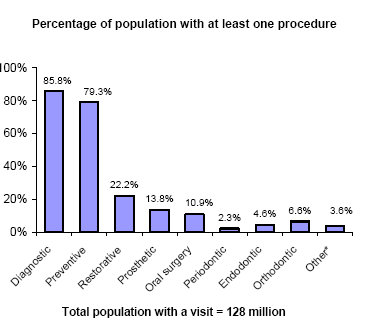
| Percentage of population with at least one procedure |
| Diagnostic |
85.8% |
| Preventive |
79.3% |
| Restorative |
22.2% |
| Prosthetic |
13.8% |
| Oral surgery |
10.9% |
| Periodontic |
2.3% |
| Endodontic |
4.6% |
| Orthodontic |
6.6% |
| Other* |
3.6% |
| Total population with a visit = 128 million |
Distribution of procedures |
| Diagnostic |
42.5% |
| Preventive |
30.4% |
| Restorative |
6.9% |
| Prosthetic |
6.4% |
| Oral surgery |
3.3% |
| Periodontic |
0.9% |
| Endodontic |
1.7% |
| Orthodontic |
6.9% |
| Other* |
1.0% |
| Total procedures = 572 million |
*Other includes treatment for TMD or TMJ (jaw pain), bonding, whiting, or bleaching.
Return to Table of Contents
What dental providers do people visit?
- In 2004, approximately 128 million people in the United
States with at least one dental visit made about 316 million
visits to a dental office.
- Approximately 82% of all dental visits were to a general
dentist, 2.7% of all visits were to an oral surgeon, and
13.2% of all visits were to an orthodontist.
- Approximately 2.4% of dental visits were to other dental
providers, including endodontists (dentists who perform
root canals) and periodontists (dentists who treat gums).
- About 34% of all dental visits included care by both a
dentist and a non-dentist team member.*
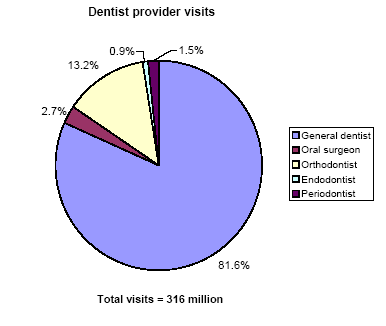
Dentist provider visits |
| General dentist |
81.6% |
| Oral surgeon |
2.7% |
| Orthodontist |
13.2% |
| Endodontist |
0.9% |
| Periodontist |
1.5% |
| Total visits = 316 million |
*Non-dentist team members include dental hygienists, dental technicians, or other non-dentist dental specialists.
How are dental visits distributed across the population?
- In 2004, the likelihood of having a dental visit varied by age, family income, race/ethnicity, and education.
- Approximately 45% of children and adolescents (less than age 21) and 39% of young adults (21-44 year olds) had at least one dental visit during the year.
- About 49% of adults (45-64 year olds) and 43% of older adults (age 65 and over) had at least one dental visit during the year.
- Although 58% of persons from a high income family had at
least one dental visit during the year, only 30% of persons from a family with low income had at least one dental visit during the year.
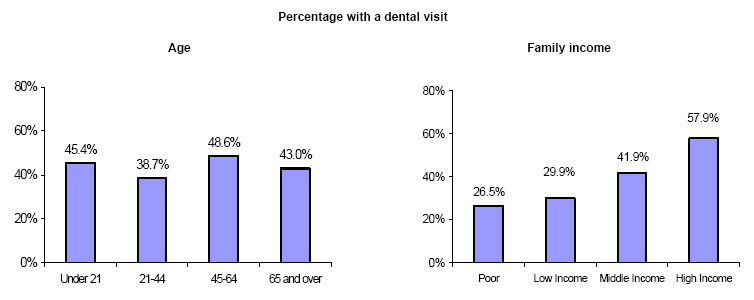
Percentage with a dental visit
|
Age |
| Under 21 |
45.4% |
| 21-44 |
38.7% |
| 45-64 |
48.6% |
| 65 and over |
43.0% |
|
Percentage with a dental visit
|
Family income |
| Poor |
26.5% |
| Low income |
29.9% |
| Middle income |
41.9% |
| High income |
57.9% |
|
- Black non-Hispanic and Hispanic persons were less likely to have a dental visit in 2004 than white non-Hispanic
persons or persons of other race/ethnicity categories.
- Persons with less than a high school education were less likely to have a dental visit in 2004 than college graduates
or children with a college graduate caregiver.
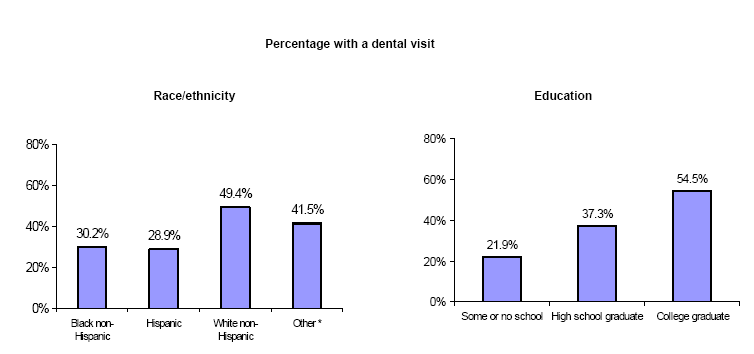
Percentage with a dental visit
|
Race/ethnicity |
| Black non-Hispanic |
30.2% |
| Hispanic |
28.9% |
| White non-Hispanic |
49.4% |
| Other* |
41.5% |
|
Percentage with a dental visit
|
Education |
| Some or no school |
21.9% |
| High school graduate |
37.3% |
| College graduate |
54.5% |
|
*Other includes non-Hispanics who reported to be of single race other than white or black (i.e., American Indian/Alaska Native, Asian, or Native
Hawaiian/Pacific Islander) as well as non-Hispanics who reported to be of multiple races (possibly including black).
Return to Table of Contents
Section 2: Dental Coverage
What proportion of the community has dental coverage?
- In 2004, approximately 158 million people, or 54% of the community population, had private dental coverage during the year.
- Approximately 12% of the community population had public dental coverage only, and 35% of the community
population had no dental coverage at all during the year.
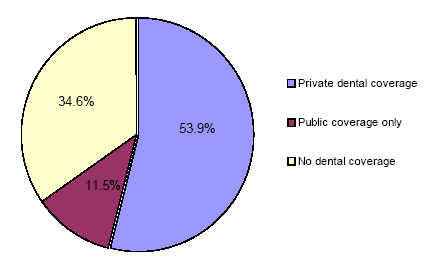
Dental Coverage |
| Private dental coverage |
53.9% |
| Public coverage only |
11.5% |
| No dental coverage |
34.6% |
How is dental coverage distributed across the population?
- In 2004, dental coverage varied by age, family income, race/ethnicity, and education.
- About 61% of middle age adults (45-64 year olds) and 24% of older adults (age 65 and over) had private dental
coverage during 2004.
- Persons from lower income families were less likely to have private dental coverage in 2004 than persons from a
family with higher income.
- Children and adolescents (less than age 21), persons who were poor, and persons from a family with low income
were more likely to have public dental coverage in 2004 than adults (age 45 and over) or persons from a family with middle or high income.
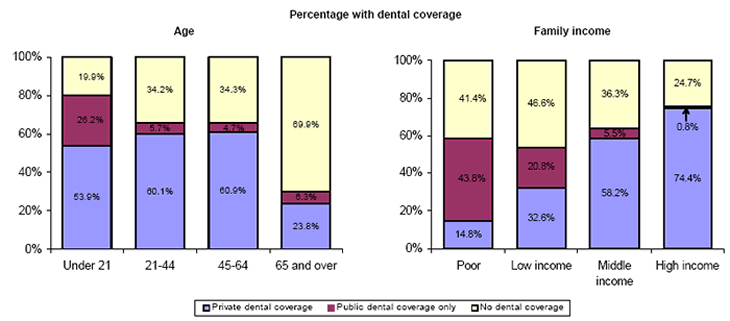
Percentage with dental coverage |
|
| |
Private dental coverage |
Public dental coverage only |
No dental coverage |
| Under 21 |
53.9% |
26.2% |
19.9% |
| 21-44 |
60.1% |
5.7% |
34.2% |
| 45-64 |
60.9% |
4.7% |
34.3% |
| 65 and over |
23.8% |
6.3% |
69.9% |
|
Percentage with dental coverage |
|
| |
Private dental coverage |
Public dental coverage only |
No dental coverage |
| Poor |
14.8% |
43.8% |
41.4% |
| Low income |
32.6% |
20.8% |
46.6% |
| Middle income |
58.2% |
5.5% |
36.3% |
| High income |
74.4% |
0.8% |
24.7% |
|
- Black non-Hispanic and Hispanic persons were more likely to
have public dental coverage and less likely to have private dental coverage in 2004 than white non-Hispanics or persons of other race/ethnicity categories.
- Persons with some or no school were more likely to have no
dental coverage, more likely to have public dental coverage, and less likely to have private dental coverage in 2004 than high school graduates or college graduates.

Percentage with dental coverage |
|
| |
Private dental coverage |
Public dental coverage only |
No dental coverage |
| Black non-Hispanic |
48.6% |
22.0% |
29.4% |
| Hispanic |
35.3% |
22.6% |
42.1% |
| White non-Hispanic |
58.7% |
6.9% |
34.3% |
| Other* |
55.4% |
14.3% |
30.3% |
|
Percentage with dental coverage |
|
| |
Private dental coverage |
Public dental coverage only |
No dental coverage |
| Some or no school |
23.1% |
25.6% |
51.3% |
| High school graduate |
48.1% |
14.4% |
37.6% |
| College graduate |
67.2% |
5.3% |
27.4% |
|
*Other includes non-Hispanics who reported to be of single race other than white or black (i.e., American Indian/Alaska Native, Asian, or Native
Hawaiian/Pacific Islander) as well as non-Hispanics who reported to be of multiple races (possibly including black).
Return to Table of Contents
Do dental care visits vary by dental coverage status?
- In 2004, 57% of the population with private dental coverage had a dental visit, 32% of the population with public
dental coverage only had a dental visit, and 27% of the population without any dental coverage had a dental visit.
- Persons with public dental coverage only had fewer visits on average in 2004 than persons with private dental
coverage or no dental coverage.

Percentage with a dental visit
|
| Overall |
43.6% |
| Private dental coverage |
56.9% |
| Public dental coverage only |
31.9% |
| No dental coverage |
26.9% |
|
Average number of dental visits for
persons with a visit
|
| Overall |
2.47% |
| Private dental coverage |
2.54% |
| Public dental coverage only |
2.06% |
| No dental coverage |
2.39% |
|
Do dental care expenses vary by dental coverage status?
- In 2004, total dental expense for the community population
of the United States was $72 billion.
- The average annual expense for a person with a dental visit
was $612 for a person with private dental coverage, $326
for a person with public dental coverage only and $482 for
a person with no dental coverage during 2004.
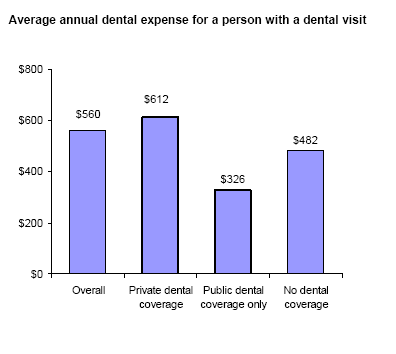
| Average annual dental
expense for a person with a dental visit |
| Overall |
$560 |
| Private dental coverage |
$612 |
| Public dental coverage only |
$326 |
| No dental coverage |
$482 |
Return to Table of Contents
Section 3: Changes from 1996 to 2004
How has the percentage of the population with a dental visit changed from 1996 to 2004?
- There was no significant change in the percentage of the population with a dental visit from 1996 to 2004.

| Percentage with a dental
visit |
| 1996 |
42.9% |
| 2004 |
43.6% |
- Children age 21 or less had a statistically significant
increase in the likelihood of having a dental visit from 1996
to 2004.
- Adults age 21-44 and individuals from a family with
middle income had a statistically significant decrease in the
likelihood of having a dental visit from 1996 to 2004.

Percentage with a dental visit |
|
| |
1996 |
2004 |
| Under 21 |
42.2% |
45.4% |
| 21-44 |
41.2% |
38.7% |
| 45-64 |
48.8% |
48.6% |
| 65 and over |
40.3% |
43.0% |
|
Percentage with
a dental visit |
|
| |
1996 |
2004 |
| Poor |
26.2% |
26.5% |
| Low Income |
28.9% |
29.9% |
| Middle Income |
44.9% |
41.9% |
| High Income |
56.6% |
57.9% |
|
- Black non-Hispanics had a statistically significant increase in the likelihood of having a dental visit from 1996 to 2004.
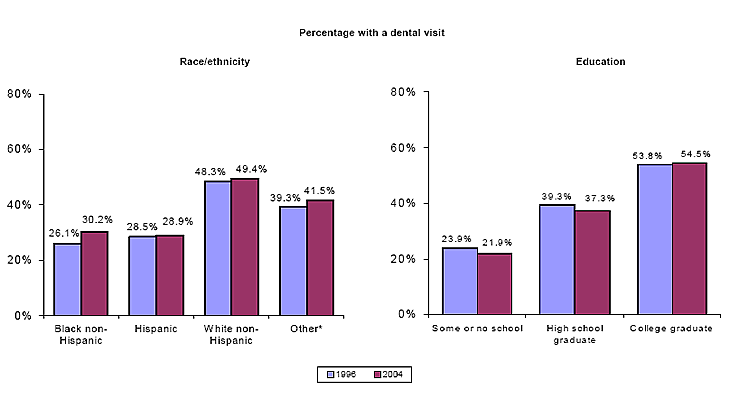
Percentage with
a dental visit |
|
| |
1996 |
2004 |
| Black non-Hispanic |
26.1% |
30.2% |
| Hispanic |
28.5% |
28.9% |
| White non-Hispanic |
48.3% |
49.4% |
| Other* |
39.3% |
41.5% |
|
Percentage with
a dental visit |
|
| |
1996 |
2004 |
| Some or no school |
23.9% |
21.9% |
| High school graduate |
39.3% |
37.3% |
| College graduate |
53.8% |
54.5% |
|
*Other includes non-Hispanics who reported to be of single race other than white or black (i.e., American Indian/Alaska Native, Asian, or Native Hawaiian/Pacific Islander) as well as non-Hispanics who reported to be of multiple races (possibly including black).
- Persons with public dental coverage only had a statistically
significant increase in the likelihood of having a dental
visit from 1996 to 2004.
- No significant changes in the likelihood of a dental visit
from 1996 to 2004 were found for people with private
dental coverage or for persons without dental coverage.
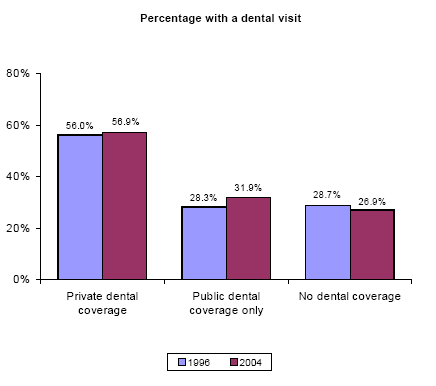
Percentage with a dental visit |
| |
1996 |
2004 |
| Private dental coverage |
56.0% |
56.9% |
| Public dental coverage |
28.3% |
31.9% |
| No dental coverage |
28.7% |
26.9% |
Return to Table of Contents
How have dental visits and dental expenses changed from 1996 to 2004?
- The average number of dental visits per person for those with a dental visit decreased from 1996 to 2004.
- Average dental expenses increased from $374 ($450 adjusted for inflation) in 1996 to $560 in 2004.
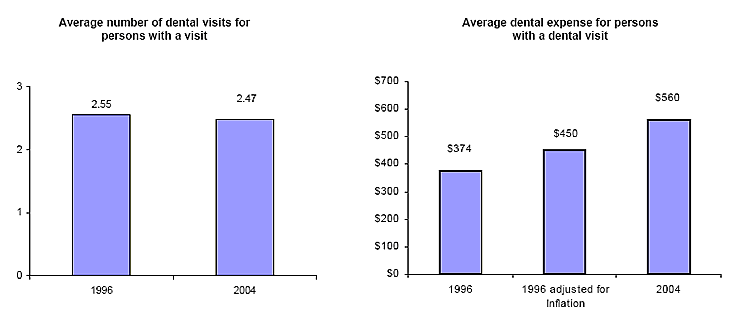
Average number of dental visits for persons
with a visit |
| 1996 |
2004 |
| 2.55 |
2.47 |
|
Average dental expense for persons with a
dental visit |
| 1996 |
$374 |
| 1996 adjusted for inflation |
$450 |
| 2004 |
$560 |
|
How have average visits per person for those with a dental visit changed from 1996 to 2004?
- The average number of dental visits per person for those with a dental visit decreased for adults age 45-64 and for adults with low or middle income from 1996 to 2004.
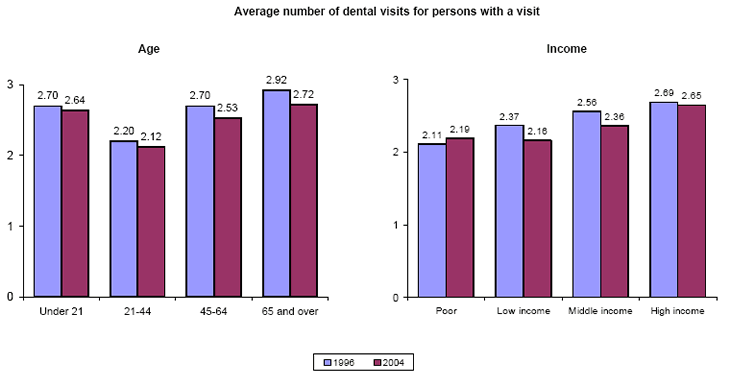
Average number of dental visits for persons
with a visit |
|
| |
1996 |
2004 |
| Under 21 |
2.70 |
2.64 |
| 21-44 |
2.20 |
2.12 |
| 45-64 |
2.70 |
2.53 |
| 65 and over |
2.92 |
2.72 |
|
Average number of dental visits for person
with a visit |
|
| |
1996 |
2004 |
| Poor |
2.11 |
2.19 |
| Low Income |
2.37 |
2.16 |
| Middle Income |
2.56 |
2.36 |
| High Income |
2.69 |
2.65 |
|
- The average number of dental visits per person for those with a dental visit decreased for college graduates from 1996 to 2004.
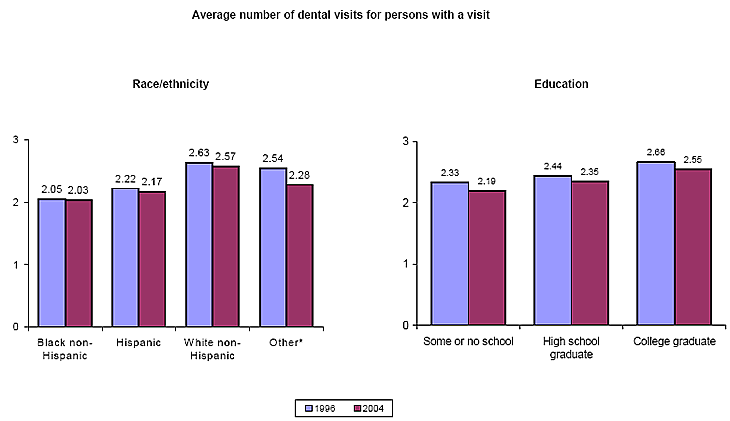
Average number of dental visits for persons
with a visit |
|
| |
1996 |
2004 |
| Black non-Hispanic |
2.05 |
2.03 |
| Hispanic |
2.22 |
2.17 |
| White non-Hispanic |
2.63 |
2.57 |
| Other* |
2.54 |
2.28 |
|
Average number of dental visits for persons
with a visit |
|
| |
1996 |
2004 |
| Some or no school |
2.33 |
2.19 |
| High school graduate |
2.44 |
2.35 |
| College graduate |
2.66 |
2.55 |
|
*Other includes non-Hispanics who reported to be of single race other than white or black (i.e., American Indian/Alaska Native, Asian, or Native
Hawaiian/Pacific Islander) as well as non-Hispanics who reported to be of multiple races (possibly including black).
- The average number of dental visits per person for those with a dental visit decreased for persons with private dental coverage from 1996 to 2004.
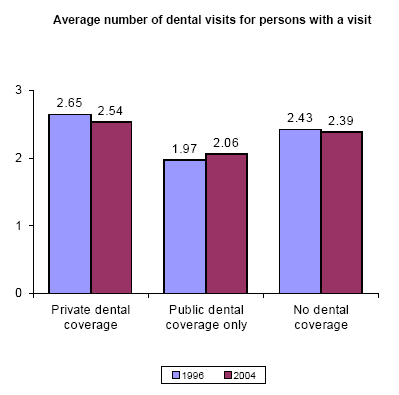
Average number of dental visits for persons with a visit |
| |
1996 |
2004 |
| Private dental coverage |
2.65 |
2.54 |
| Public dental coverage only |
1.97 |
2.06 |
| No dental coverage |
2.43 |
2.39 |
Return to Table of Contents
How has the average dental expense for those with a dental visit changed from 1996 to 2004?
- For each age the average expense (adjusted for inflation) increased from 1996 to 2004.
- For each income category except for middle income the average expense (adjusted for inflation) increased from
1996 to 2004.
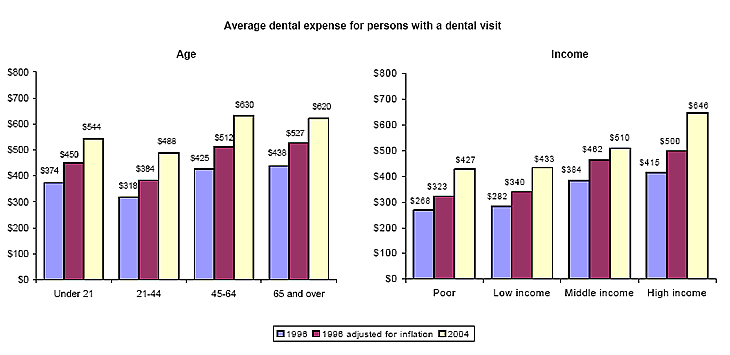
Average dental expense for persons with a
dental visit |
|
| |
1996 |
1996 adjusted for inflation |
2004 |
| Under 21 |
$374 |
$450 |
$544 |
| 21-44 |
$318 |
$384 |
$488 |
| 45-64 |
$425 |
$512 |
$630 |
| 65 and over |
$438 |
$527 |
$620 |
|
Average dental expense for persons with a
dental visit |
|
| |
1996 |
1996 adjusted for inflation |
2004 |
| Poor |
$268 |
$323 |
$427 |
| Low Income |
$282 |
$340 |
$433 |
| Middle Income |
$384 |
$462 |
$510 |
| High Income |
$415 |
$500 |
$646 |
|
- White non-Hispanics and Hispanics and persons of other race/ethnicity categories had a statistically significant
increase in expenses from 1996 to 2004.
- For each education category, the average expense (adjusted for inflation) increased from 1996 to 2004.
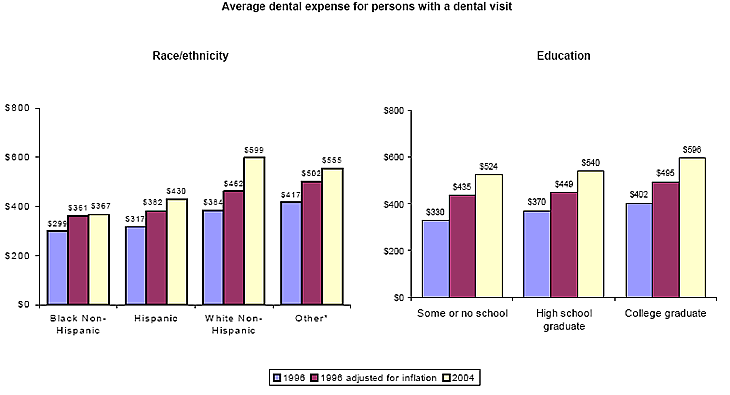
Average dental expense for persons with a
dental visit |
|
| |
1996 |
1996 adjusted for inflation |
2004 |
| Black Non-Hispanic |
$299 |
$361 |
$367 |
| Hispanic |
$317 |
$382 |
$430 |
| White Non-Hispanic |
$384 |
$462 |
$599 |
| Other* |
$417 |
$502 |
$555 |
|
Average dental expense for persons with a
dental visit |
|
| |
1996 |
1996 adjusted for inflation |
2004 |
| Some or no school |
$330 |
$435 |
$524 |
| High school graduate |
$370 |
$449 |
$540 |
| College graduate |
$402 |
$495 |
$596 |
|
*Other includes non-Hispanics who reported to be of single race other than white or black (i.e., American Indian/Alaska Native, Asian, or Native
Hawaiian/Pacific Islander) as well as non-Hispanics who reported to be of multiple races (possibly including black).
- For each dental coverage category the average expense (adjusted for inflation) increased from 1996 to 2004.
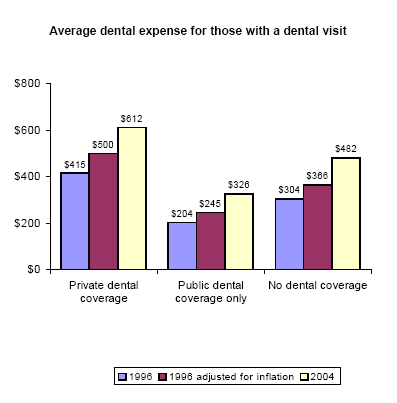
Average dental expense for those with a dental visit |
| |
1996 |
1996 adjusted for inflation |
2004 |
| Private dental coverage |
$415 |
$500 |
$612 |
| Public dental coverage only |
$204 |
$245 |
$326 |
| No dental coverage |
$304 |
$366 |
$482 |
How has the likelihood of having at least one type of procedure changed from 1996 to 2004?
- People were more likely to have at least one diagnostic or preventive procedure and less likely to have one restorative, prosthetic, surgical, or other procedure in 2004 than in 1996.

Percentage of the population with at least one procedure |
| |
1996 |
2004 |
| Diagnostic |
82.7% |
85.8% |
| Preventive |
74.6% |
79.3% |
| Restorative |
24.2% |
22.2% |
| Prosthetic |
15.2% |
13.8% |
| Oral surgery |
12.5% |
10.9% |
| Periodontic |
2.6% |
2.3% |
| Endodontic |
5.1% |
4.6% |
| Orthodontic |
5.9% |
6.6% |
| Other* |
4.5% |
3.6% |
*Other includes treatment for TMD or TMJ (jaw pain), bonding, whiting, or bleaching.
How has the distribution of procedures changed from 1996 to 2004?
- The total number of procedures increased from about 496
million in 1996 to about 572 million in 2004 (data not
shown).
- As a percentage of all procedures, diagnostic and
preventive procedures increased while restorative,
prosthetic, surgical, endodontic, and other procedures
decreased from 1996 to 2004.
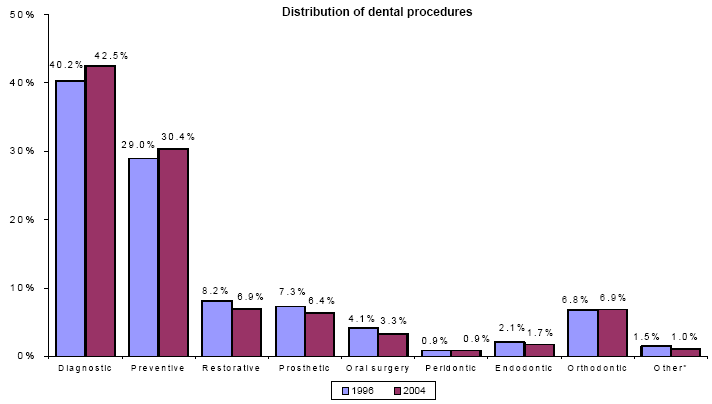
Distribution of dental procedures |
| |
1996 |
2004 |
| Diagnostic |
40.2% |
42.5% |
| Preventive |
29.0% |
30.4% |
| Restorative |
8.2% |
6.9% |
| Prosthetic |
7.3% |
6.4% |
| Oral surgery |
4.1% |
3.3% |
| Periodontic |
0.9% |
0.9% |
| Endodontic |
2.1% |
1.7% |
| Orthodontic |
6.8% |
6.9% |
| Other* |
1.5% |
1.0% |
*Other includes treatment for TMD or TMJ (jaw pain), bonding, whiting, or bleaching. Return
to Table of Contents
How have dental expenses changed from 1996 to 2004 by category of procedure?
- Average dental expenses increased from $115 ($139 adjusted for inflation) in 1996 to $172 and from $136 ($164
adjusted for inflation) in 1996 to $217 for preventive/
diagnostic procedures and restorative procedures, respectively, in 2004.
- Expenses for other dental procedures (periodontic,
orthodontic, prosthetic, endodontic, and oral surgery) increased from $213 ($257 adjusted for inflation) in 1996 to $354 in 2004.
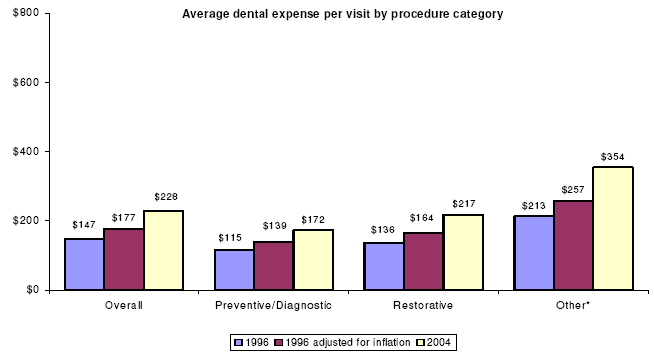
Average dental expense per visit by procedure category |
| |
1996 |
1996 adjusted for inflation |
2004 |
| Overall |
$147 |
$177 |
$288 |
| Preventive/Diagnostic |
$115 |
$139 |
$172 |
| Restorative |
$136 |
$164 |
$217 |
| Other* |
$213 |
$257 |
$354 |
*Other includes periodontic (gums), orthodontic (braces), prosthetic (crown, bridges, and dentures), endodontic (root canals), oral surgery, treatment for
TMD or TMJ (jaw pain), and bonding, whiting, or bleaching.
How has the percentage of people with dental coverage changed
from 1996 to 2004?
- The percentage of people with public dental coverage only increased from 1996 to 2004.
- The percentage of people without any dental coverage decreased from 1996 to 2004.
- No change was observed in private dental coverage.

Percentage with dental coverage |
| |
1996 |
2004 |
| Private dental coverage |
52.2% |
53.9% |
| Public dental coverage only |
9.4% |
11.5% |
| No dental coverage |
38.4% |
34.6% |
How has distribution of dental coverage changed
from 1996 to 2004?
- Children were more likely to have public dental coverage only and less likely to have no dental coverage in 2004 than in 1996.
- Adults age 45-64 were less likely to have no dental coverage in 2004 than in 1996.

Changes in coverage by age |
|
Children
age birth-20 |
| |
1996 |
2004 |
| Private dental coverage |
53.2% |
53.9% |
| Public dental coverage only |
18.0% |
26.2% |
| No dental coverage |
28.8% |
19.9% |
|
Changes in coverage by age |
|
| |
1996 |
2004 |
| Private dental coverage |
57.9% |
60.1% |
| Public dental coverage only |
5.8% |
5.7% |
| No dental coverage |
36.3% |
34.2% |
|
Changes in coverage by age |
|
Adults
age 45-64 |
| |
1996 |
2004 |
| Private dental coverage |
58.7% |
60.9% |
| Public dental coverage only |
3.9% |
4.7% |
| No dental coverage |
37.4% |
34.3% |
|
Changes in coverage by age |
|
Older
adults age 65 and above |
| |
1996 |
2004 |
| Private dental coverage |
23.2% |
23.8% |
| Public dental coverage only |
7.9% |
6.3% |
| No dental coverage |
68.9% |
69.9% |
|
- Persons from a family with low income were more likely to
have public dental coverage only and less likely to have no dental coverage in 2004 than in 1996.
- Persons from a family with middle income were more likely to have public dental coverage only in 2004 than in
1996.
- Persons from a family with high income were more likely to have private
dental coverage and less likely to have no dental coverage in 2004 than
in 1996.
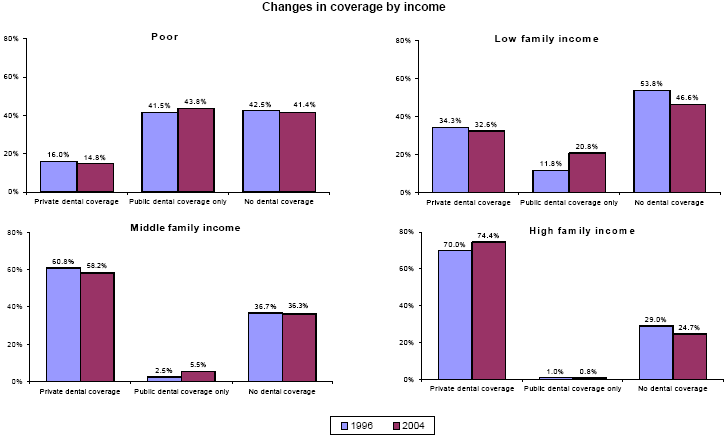
Changes in coverage by income |
|
Poor |
| |
1996 |
2004 |
| Private dental coverage |
16.0% |
14.8% |
| Public dental coverage only |
41.5% |
43.8% |
| No dental coverage |
42.5% |
41.4% |
|
Changes in coverage by income |
|
Low
family income |
| |
1996 |
2004 |
| Private dental coverage |
34.3% |
32.6% |
| Public dental coverage only |
11.8% |
20.8% |
| No dental coverage |
53.8% |
46.6% |
|
Changes in coverage by income |
|
Middle
income family |
| |
1996 |
2004 |
| Private dental coverage |
60.8% |
58.2% |
| Public dental coverage only |
2.5% |
5.5% |
| No dental coverage |
36.7% |
36.3% |
|
Changes in coverage by income |
|
High
family income |
| |
1996 |
2004 |
| Private dental coverage |
70.0% |
74.4% |
| Public dental coverage only |
1.0% |
0.8% |
| No dental coverage |
29.0% |
24.7% |
|
- Black non-Hispanics were less likely to have no dental coverage in 2004 than in 1996.
- White non-Hispanics were more likely to have private or public dental coverage and less likely to have no dental coverage from 1996 to 2004.

Changes in coverage by race/ethnicity |
|
Black
non-Hispanic |
| |
1996 |
2004 |
| Private dental coverage |
43.8% |
48.6% |
| Public dental coverage only |
19.7% |
22.0% |
| No dental coverage |
36.5% |
29.4% |
|
Changes in coverage by race/ethnicity |
|
Hispanic |
| |
1996 |
2004 |
| Private dental coverage |
34.7% |
35.3% |
| Public dental coverage only |
21.9% |
22.6% |
| No dental coverage |
43.4% |
42.1% |
|
Changes in coverage by race/ethnicity |
|
White
non-Hispanic |
| |
1996 |
2004 |
| Private dental coverage |
56.3% |
58.7% |
| Public dental coverage only |
5.4% |
6.9% |
| No dental coverage |
38.3% |
34.3% |
|
Changes in coverage by race/ethnicity |
|
Other* |
| |
1996 |
2004 |
| Private dental coverage |
53.4% |
55.4% |
| Public dental coverage only |
14.5% |
14.3% |
| No dental coverage |
32.1% |
30.3% |
|
*Other includes non-Hispanics who reported to be of single race other than white or black (i.e., American Indian/Alaska Native, Asian, or Native
Hawaiian/Pacific Islander) as well as non-Hispanics who reported to be of multiple races (possibly including black).
- For each education category, people were more likely to have public dental coverage only and less likely to have no dental coverage in 2004 than in 1996.
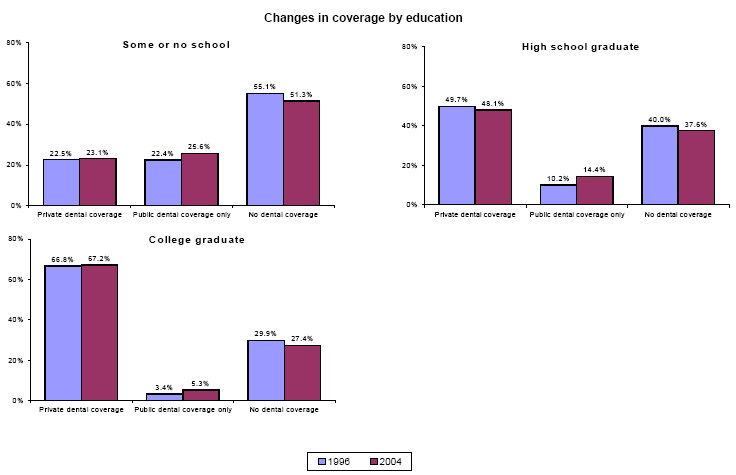
Changes in coverage by education |
|
Some or
no school |
| |
1996 |
2004 |
| Private dental coverage |
22.5% |
23.1% |
| Public dental coverage only |
22.4% |
25.6% |
| No dental coverage |
55.1% |
51.3% |
|
Changes in coverage by education |
|
High
school graduate |
| |
1996 |
2004 |
| Private dental coverage |
49.7% |
48.1% |
| Public dental coverage only |
10.2% |
14.4% |
| No dental coverage |
40.0% |
37.6% |
|
Changes in coverage by education |
|
College
graduate |
| |
1996 |
2004 |
| Private dental coverage |
66.8% |
67.2% |
| Public dental coverage only |
3.4% |
5.3% |
| No dental coverage |
29.9% |
27.4% |
|
Return to Table of Contents
Chapter 2.
Children: Birth–Age 20
Section 1: Dental Use
What proportion of children has a dental visit?
- In 2004, there were about 86 million children in the United States.
- Approximately 45% of children had at least one dental visit during the year.
- The average expense was $544 per year for children with a dental visit, and the average number of visits was 2.6 visits per child for children with a visit (data not shown).
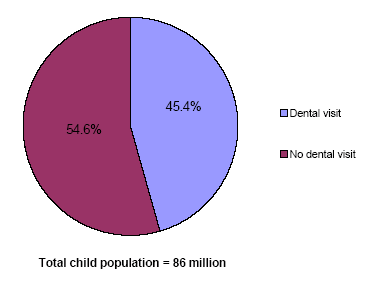
What
proportion of children has a dental visit? |
| Dental visit |
45.4% |
| No dental visit |
54.6% |
| Total child population = 86 million |
What procedures do children receive?
- In 2004, approximately 39 million children with at least one dental visit received about 186 million dental
procedures in the United States.
- Approximately, 88% of children receiving at least one dental
visit had at least one diagnostic procedure (examination
or x-ray), and about 82% of children had at least one preventive procedure (cleaning, fluoride, or sealant) during the year.
- Together, approximately 72% of all procedures were diagnostic (39.1%) or preventive (33.1%) during 2004.

| Percentage of children
with at least one procedure |
| Diagnostic |
88.0% |
| Preventive |
82.0% |
| Restorative |
20.4% |
| Prosthetic |
2.4% |
| Oral surgery |
8.5% |
| Orthodontic |
17.6% |
| Other* |
3.5% |
| Total population with a visit = 39
million |
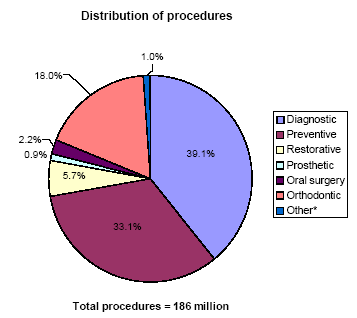
|
Distribution of procedures |
| Diagnostic |
39.1% |
| Preventive |
33.1% |
| Restorative |
5.7% |
| Prosthetic |
0.9% |
| Oral surgery |
2.2% |
| Orthodontic |
18.0% |
| Other* |
1.0% |
| Total procedures = 186 million |
*Other includes periodontics (gums), endodontics (root canals), treatment for TMD or TMJ (jaw pain), and bonding, whiting, or bleaching.
What dental providers do children visit?
- In 2004, children made about 103 million visits to a dental office in the United States.
- Approximately 63% of all children’s dental visits were to a
General Dentist. While 2% of children’s dental visits were to an oral surgeon, 35% were to an orthodontist.
- Less than 1% of all children’s dental visits were to other dental providers, including endodontists (dentists who
perform root canals) and periodontists (dentists who treat
gums).
- About 29% of all dental visits included care by both a dentist and a non-dentist team member.*

|
Dentist provider visits |
| General dentist |
62.9% |
| Oral surgeon |
2.0% |
| Orthodontist |
34.6% |
| Endodontist or Periodontist |
0.5% |
| Total visits = 103 million |
*Non-dentist team members include dental hygienists, dental technicians, or other non-dentist dental specialists.
How are dental visits distributed across the population?
- In 2004, the likelihood of a child having a dental visit varied by age, family income, race/ethnicity, and education.
- Approximately 48% of the adolescents age 13-20 and 59% of children age 6-12 had at least one dental visit during the year.
- While 62% of children from a high-income family had at least one dental visit during the year, 34% of children from
a family with low income had at least one dental visit during the year.
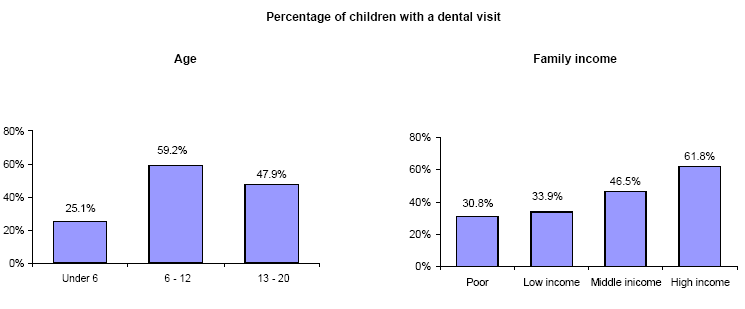
Percentage of children with a dental visit |
|
Age |
| Under 6 |
25.1% |
| 6 - 12 |
59.2% |
| 13 - 20 |
47.9% |
|
|
Percentage of children with a dental visit |
Family Income |
| Poor |
30.8% |
| Low income |
33.9% |
| Middle income |
46.5% |
| High income |
61.8% |
|
- Black non-Hispanic and Hispanic children were less likely to have a dental visit in 2004 than white non-Hispanic
children or children of other race/ethnicity categories.
- Children with a caregiver with less than high school education were less likely to have a dental visit in 2004 than children with a high school graduate or college graduate caregiver.
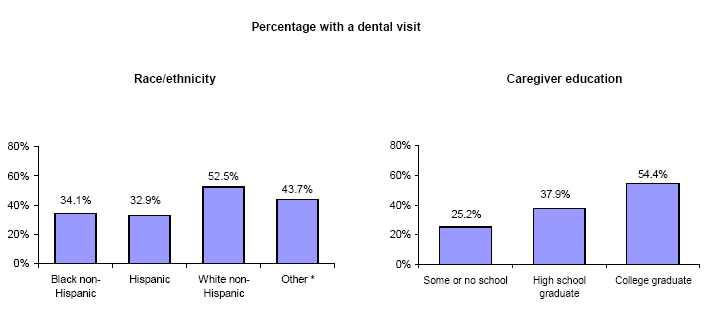
Percentage with a dental visit |
|
Race/ethnicity |
| Black non-Hispanic |
34.1% |
| Hispanic |
32.9% |
| White non-Hispanic |
52.5% |
| Other* |
43.7% |
|
Percentage with a dental visit |
|
Caregiver
education |
| Some or no school |
25.2% |
| High school graduate |
37.9% |
| College graduate |
54.4% |
|
*Other includes non-Hispanics who reported to be of single race other than white or black (i.e., American Indian/Alaska Native, Asian, or Native
Hawaiian/Pacific Islander) as well as non-Hispanics who reported to be of multiple races (possibly including black).
Return to Table of Contents
Section 2: Dental Coverage
What proportion of children has dental coverage?
- In 2004, approximately 46 million children or 54% of children had private dental coverage during the year.
- Approximately 26% of all children had public dental coverage only, and slightly less than 20% of all children had no dental coverage.
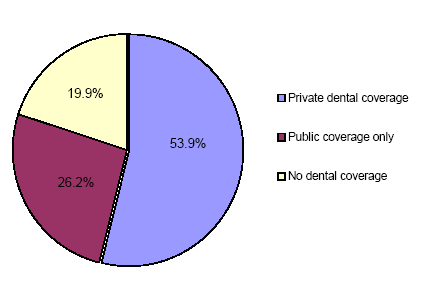
|
What proportion of children has
dental coverage? |
| Private dental coverage |
53.9% |
| Public dental coverage |
26.2% |
| No dental coverage |
19.9% |
How is dental coverage distributed across the population?
- In 2004, dental coverage varied by age, family income, race/e thnicity, and education.
- Children from a family with lower income were less likely to have private dental coverage and more likely to have
public dental coverage only in 20 04 than children from a family with higher income.
- Children from a family with low or middle income were more likely to have no dental coverage compared with poor
children or children from a family with high income.

Percentage with dental coverage |
|
| |
Private dental coverage |
Public dental coverage only |
No dental coverage |
| Under 6 |
49.1% |
33.1% |
17.8% |
| 6 - 12 |
55.9% |
27.0% |
17.1% |
| 13 - 20 |
55.7% |
20.7% |
23.6% |
|
Percentage with dental coverage |
|
| |
Private dental coverage |
Public dental coverage only |
No dental coverage |
| Poor |
13.9% |
73.4% |
12.7% |
| Low income |
34.3% |
40.9% |
24.8% |
| Middle income |
65.6% |
11.8% |
22.5% |
| High income |
80.3% |
1.9% |
17.8% |
|
- Black non-Hispanic and Hispanic children were more likely to have public dental coverage and less likely to have
private dental coverage in 2004 than white non-Hispanics or children of other race/ethnicity categories.
- Children with a caregiver with some or no school were more likely to have public dental coverage and less likely
to have private dental coverage in 2004 than children with
high school graduate or college graduate caregivers.
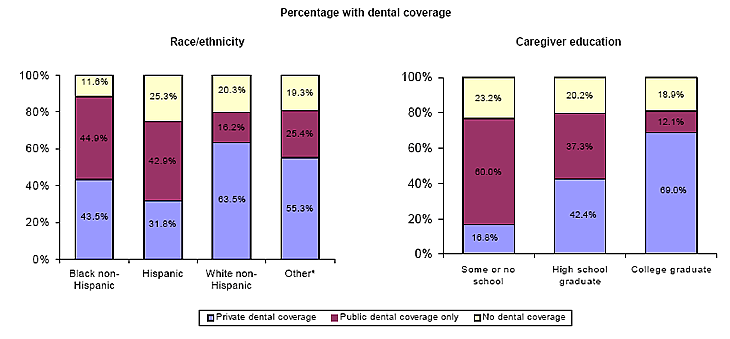
Percentage with dental coverage |
|
| |
Private dental coverage |
Public dental coverage only |
No dental coverage |
| Black non-Hispanic |
43.5% |
44.9% |
11.6% |
| Hispanic |
31.8% |
42.9% |
25.3% |
| White non-Hispanic |
63.5% |
16.2% |
20.3% |
| Other* |
55.3% |
25.4% |
19.3% |
|
Percentage with dental coverage |
|
| |
Private dental coverage |
Public dental coverage only |
No dental coverage |
| Some or no school |
16.8% |
60.0% |
23.2% |
| High school graduate |
42.4% |
37.3% |
20.2% |
| College graduate |
69.0% |
12.1% |
19.9% |
|
*Other includes non-Hispanics who reported to be of single race other than
white or black (i.e., American Indian/Alaska Native, Asian, or
Native Hawaiian/Pacific Islander) as well as non-Hispanics who
reported to be of multiple races (possibly including black).
Do dental care visits vary by dental coverage status?
- In 2004, while 58% of children with private dental coverage had a dental visit, 34% of children with public dental coverage only
had a dental visit, and 28% of children without any dental coverage had a dental visit.

Percentage with a dental visit |
| Overall |
45.4% |
| Private dental coverage |
57.5% |
| Public dental coverage only |
34.1% |
| No dental coverage |
27.5% |
|
Average number of dental visits for children
with a visit |
|
Overall |
2.64 |
| Private dental coverage |
2.85 |
| Public dental coverage only |
1.88 |
| No dental coverage |
2.71 |
|
Do dental care expenses vary by dental coverage status?
- In 2004, the total dental expense for children in the United States
was $21 billion.
- The average annual expense for children with a visit was $635 for children with private dental coverage and $272 for children with public dental coverage only during 2004.
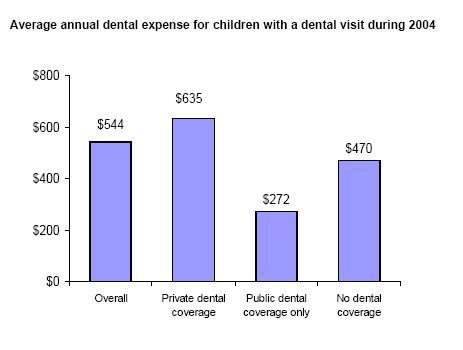
|
Average annual dental expense for
children with a dental visit during 2004 |
| Overall |
$544 |
| Private dental coverage |
$635 |
| Public dental coverage only |
$272 |
| No dental coverage |
$470 |
- The average annual orthodontic expense was $1,375, and the average annual non-orthodontic expense was $318 for children during 2004.
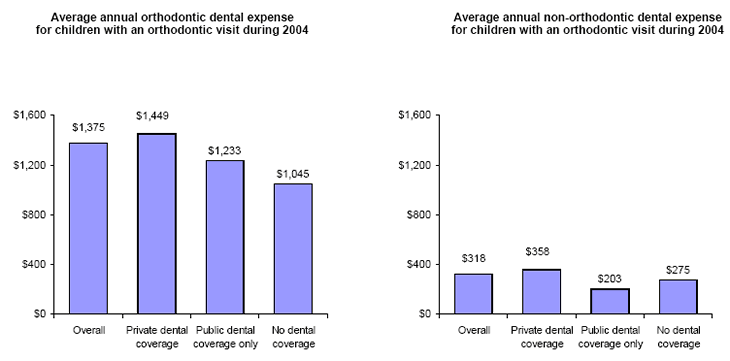
Average
annual orthodontic dental expense
for children with an
orthodontic visit during 2004
|
| Overall |
$1,375 |
| Private dental coverage |
$1,449 |
| Public dental coverage only |
$1,233 |
| No dental coverage |
$1,045 |
|
Average
annual non-orthodontic dental expense
for children with an
orthodontic visit during 2004
|
|
Overall |
$318 |
| Private dental coverage |
$358 |
| Public dental coverage only |
$203 |
| No dental coverage |
$275 |
|
Return to Table of Contents
Section 3: Changes from 1996 to 2004
How has the percentage of children with a dental visit changed from 1996 to 2004?
- Children were more likely to have a dental visit in 2004 compared with 1996, which corresponds with the enactment of SCHIP
(State Children’ s Health Insurance Program) an d public dental coverage only extensions among children.
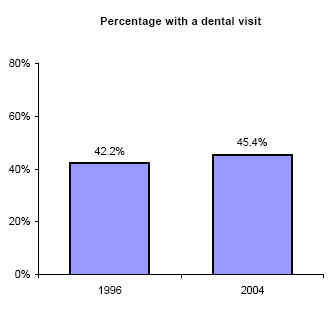
|
Percentage with a dental visit |
| 1996 |
42.2% |
| 2004 |
45.4% |
- Children under age 6 , children age 6- 12, an d low-income children experienced an increase in the likelihood of a dental visit between 1996 and 2004.
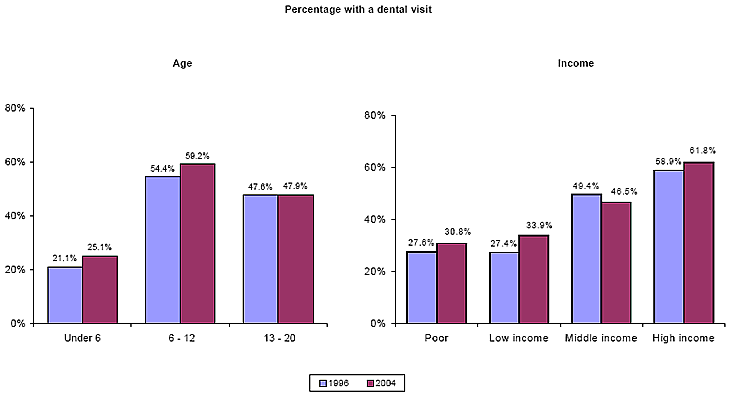
Percentage with a dental visit |
|
| |
1996 |
2004 |
| Under 6 |
21.1% |
25.1% |
| 6 - 12 |
54.4% |
59.2% |
| 13 - 20 |
47.6% |
47.9% |
|
Percentage with a dental visit |
|
| |
1996 |
2004 |
| Poor |
27.6% |
30.8% |
| Low Income |
27.4% |
33.9% |
| Middle Income |
49.4% |
46.5% |
| High Income |
58.9% |
61.8% |
|
- Black non-Hispanic and Hispanic children had a statistically significant increase in the likelihood of having a dental visit from 1996 to 2004.
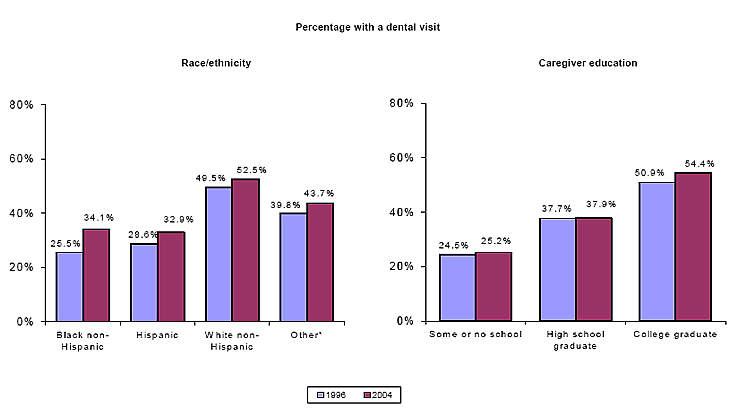
Percentage with
a dental visit |
|
| |
1996 |
2004 |
| Black non-Hispanic |
25.5% |
34.1% |
| Hispanic |
28.6% |
32.9% |
| White non-Hispanic |
49.5% |
52.5% |
| Other* |
39.8% |
43.7% |
|
Percentage with
a dental visit |
|
| |
1996 |
2004 |
| Some or no school |
24.5% |
25.2% |
| High school graduate |
37.7% |
37.9% |
| College graduate |
50.9% |
54.4% |
|
*Other includes non-Hispanics who reported to be of single race other than
white or black (i.e., American Indian/Alaska Native, Asian, or
Native Hawaiian/Pacific Islander) as well as non-Hispanics who
reported to be of multiple
races (possibly including black).
- Children with public dental coverage only had an increase in the likelihood of having a dental visit from 1996 to 2004.
- No significant change in the likelihood of having a dental visit from 1996 to 2004 was found for children with private
dental coverage or for children without dental coverage.
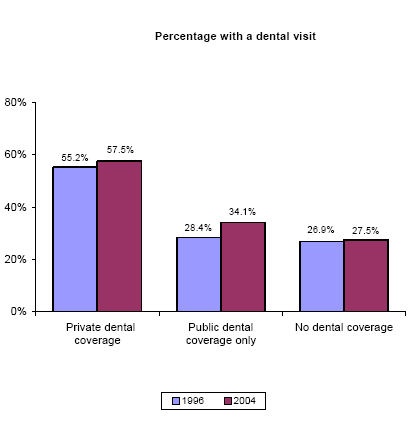
Percentage with
a dental visit |
| |
1996 |
2004 |
| Private dental coverage |
55.2% |
57.5% |
| Public dental coverage
only |
28.4% |
34.1% |
| No dental coverage |
26.9% |
27.5% |
|
How have dental visits and dental expenses changed
from 1996 to 2004?
- There was no statistically significant change in the average number
of dental visits per child for those with a dental visit from 1996 to
2004.
- Average dental expenses increased from $374 ($450 adjusted for inflation) in 1996 to $544 in 2004.
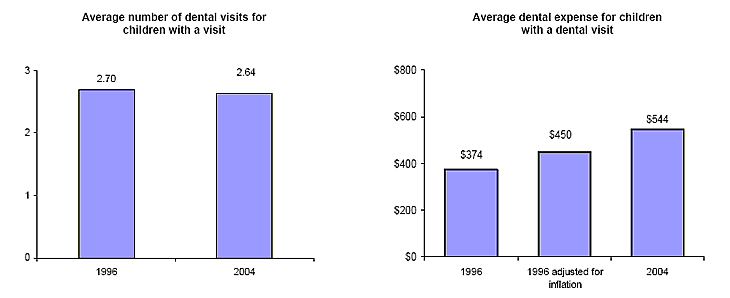
Average number of dental visits for
children with a visit |
| 1996 |
2.70 |
| 2004 |
2.64 |
|
Average dental expense for children
with a dental visit |
| 1996 |
$374 |
| 1996 adjusted for
inflation |
$450 |
| 2004 |
$544 |
|
- The average dental orthodontic expense increased from $930 ($1,120 adjusted for inflation) in 1996 to $ 1,375 in
2004.
- The average dental non-orthodontic expense increased from $229 ($275 adjusted for inflation) in 1996 to $318 in 2004.
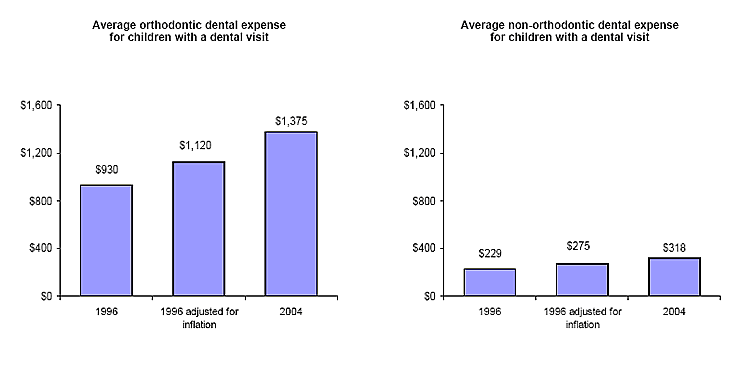
Average orthodontic dental expense
for children with a dental
visit |
| 1996 |
$930 |
| 1996 adjusted for inflation |
$1,120 |
| 2004 |
$1,375 |
|
Average non-orthodontic dental expense
for children with a dental
visit |
| 1996 |
$229 |
| 1996 adjusted for
inflation |
$275 |
| 2004 |
$318 |
|
How have average visits per child for those with a dental visit changed from 1996 to 2004?
- There were no statistically significant changes in the average number of visits for children with a dental visit by age or income from 1996 to 2004.
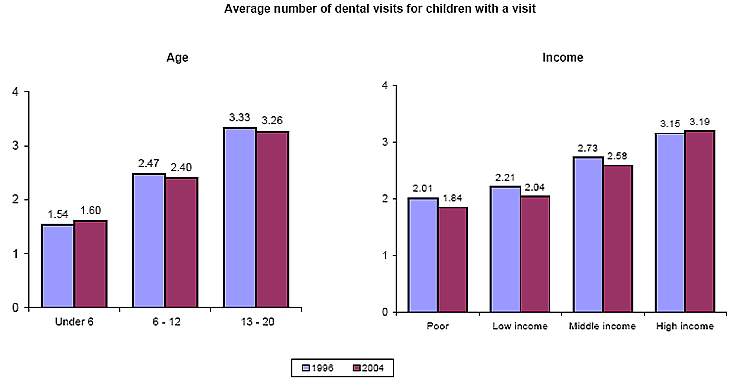
Average number of dental visits
for children with a visit |
|
| |
1996 |
2004 |
| Under 6 |
1.54 |
1.60 |
| 6 - 12 |
2.47 |
2.40 |
| 13 - 20 |
3.33 |
3.26 |
|
Average number of dental visits
for children with a visit |
|
| |
1996 |
2004 |
| Poor |
2.01 |
1.84 |
| Low Income |
2.21 |
2.04 |
| Middle Income |
2.73 |
2.58 |
| High Income |
3.15 |
3.19 |
|
- There were no statistically significant changes in the average number of visits by children with a dental visit by race/ethnicity or
caregiver education from 1996 to 2004.
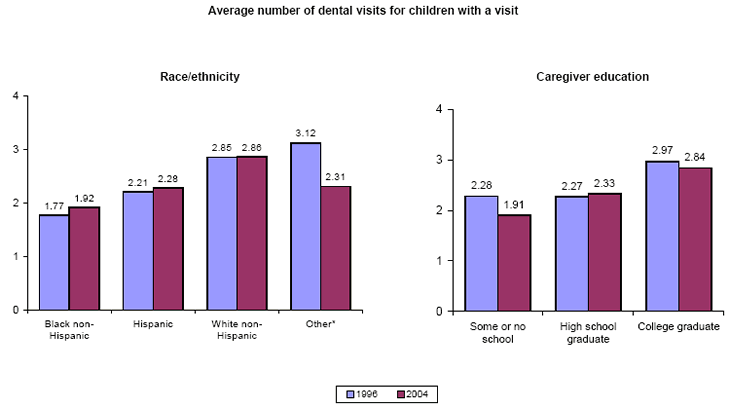
Average number of dental visits
for children with a visit |
|
| |
1996 |
2004 |
| Black non-Hispanic |
1.77 |
1.92 |
| Hispanic |
2.21 |
2.28 |
| White non-Hispanic |
2.85 |
2.86 |
| Other* |
3.12 |
2.31 |
|
Average number of dental visits
for children with a visit |
|
| |
1996 |
2004 |
| Some or no school |
2.28 |
1.91 |
| High school graduate |
2.27 |
2.33 |
| College graduate |
2.97 |
2.84 |
|
*Other includes non-Hispanics who reported to be of single race other than white or black (i.e., American Indian/Alaska Native, Asian, or Native
Hawaiian/Pacific Islander) as well as non-Hispanics who reported to be of multiple races (possibly including black).
- There were no significant changes by dental coverage status in the average number of visits for children with a dental visit from 1996 to 2004.
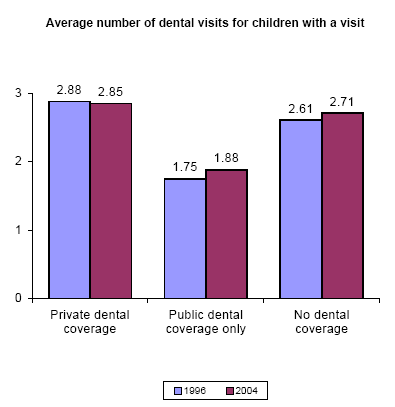
Average number of dental visits for children
with a visit |
| |
1996 |
2004 |
| Private dental coverage |
2.88 |
2.85 |
| Public dental coverage
only |
1.75 |
1.88 |
| No dental coverage |
2.61 |
2.71 |
|
How has the average dental expense for children with a dental visit changed from 1996 to 2004?
- The average expense (adjusted for inflation) for children under age 6 and children age 6-12 increased from 1996 to 2004.
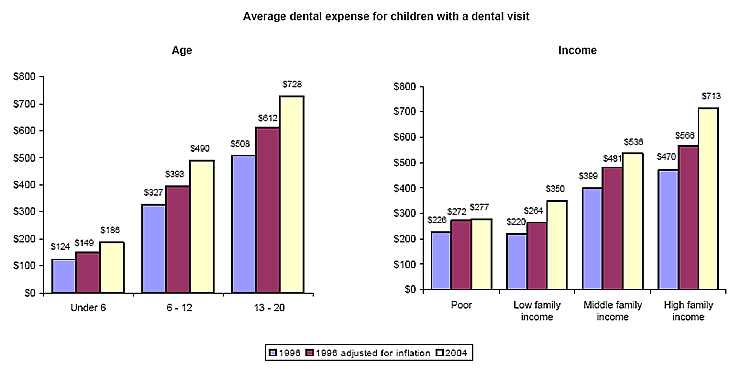
Average dental expense for children with a
dental visit |
|
| |
1996 |
1996 adjusted for inflation |
2004 |
| Under 6 |
$124 |
$149 |
$186 |
| 6 - 12 |
$327 |
$393 |
$490 |
| 13 - 20 |
$508 |
$612 |
$728 |
|
Average dental expense for children with a
dental visit |
|
| |
1996 |
1996 adjusted for inflation |
2004 |
| Poor |
$226 |
$272 |
$277 |
| Low family income |
$220 |
$264 |
$350 |
| Middle family income |
$399 |
$481 |
$536 |
| High family income |
$470 |
$566 |
$713 |
|
- White non-Hispanic children and children with a college graduate caregiver had a statistically significant increase in average dental expenses (adjusted for inflation) from 1996 to 2004.
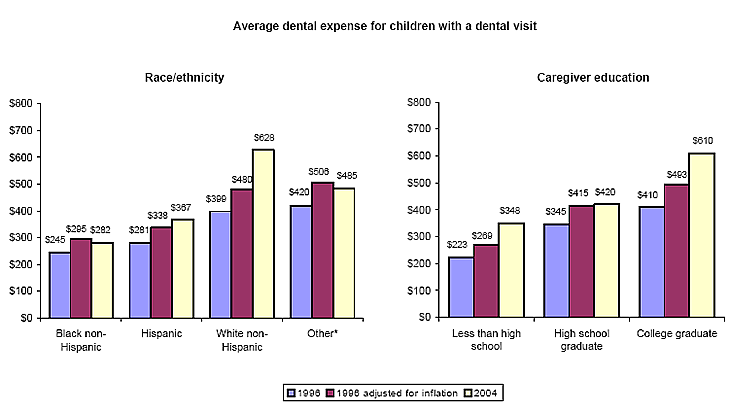
Average dental expense for children with a
dental visit |
|
| |
1996 |
1996 adjusted for inflation |
2004 |
| Black Non-Hispanic |
$245 |
$295 |
$282 |
| Hispanic |
$281 |
$338 |
$367 |
| White Non-Hispanic |
$399 |
$480 |
$628 |
| Other* |
$420 |
$506 |
$485 |
|
Average dental expense for children with a
dental visit |
|
| |
1996 |
1996 adjusted for inflation |
2004 |
| Less than high school |
$223 |
$269 |
$348 |
| High school graduate |
$345 |
$415 |
$420 |
| College graduate |
$410 |
$493 |
$610 |
|
*Other includes non-Hispanics who reported to be of single race other than white or black (i.e., American Indian/Alaska Native, Asian, or Native
Hawaiian/Pacific Islander) as well as non-Hispanics who reported to be of multiple races (possibly including black).
- For children with private or public dental coverage only the
average dental expense (adjusted for inflation) increased
from 1996 to 2004.
- No significant change (adjusted for inflation) was observed for children without dental coverage from 1996 to 2004.
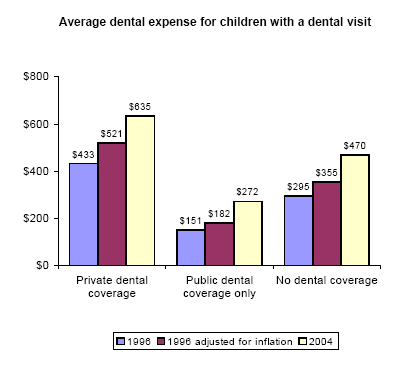
Average dental expense for children with a dental visit |
| |
1996 |
1996 adjusted for inflation |
2004 |
| Private dental coverage |
$433 |
$521 |
$635 |
| Public dental coverage only |
$151 |
$182 |
$272 |
| No dental coverage |
$295 |
$355 |
$470 |
How has the likelihood of having at least one type of procedure changed from 1996 to 2004?
- Children were more likely to have at least one preventive procedure and less likely to have one oral surgery procedure in 2004 than in 1996.
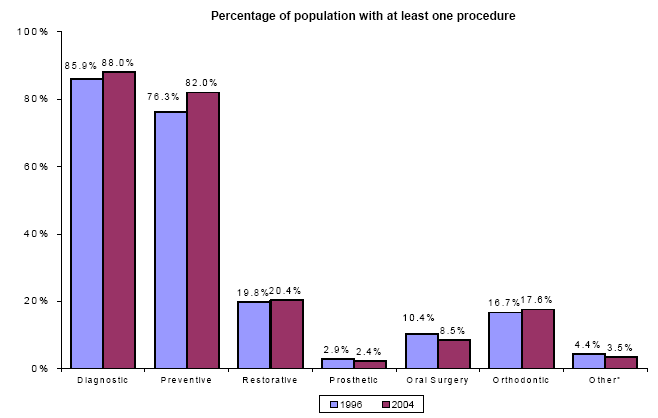
| Percentage of population
with at least one procedure |
| |
1996 |
2004 |
| Diagnostic |
85.9% |
88.0% |
| Preventive |
76.3% |
82.0% |
| Restorative |
19.8% |
20.4% |
| Prosthetic |
2.9% |
2.4% |
| Oral surgery |
10.4% |
8.5% |
| Orthodontic |
16.7% |
17.6% |
| Other* |
4.4% |
3.5% |
*Other includes periodontics (gums), endodoontics (root canals), treatment for TMD or TMJ (jaw pain), and bonding, whiting, or bleaching.
How has the distribution of procedures changed from 1996 to 2004?
- The total number of procedures increased from about 156 million in 1996 to about 186 million in 2004 (data not
shown).
- As a percentage of all procedures, from 1996 to 2004 preventive procedures increased while oral surgery and
other procedure types decreased.
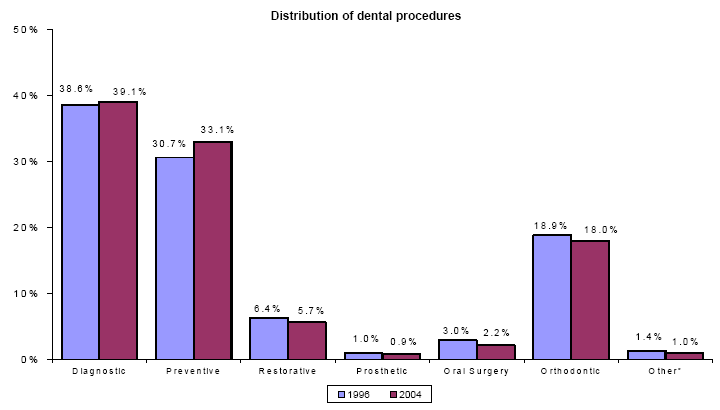
| Distribution of dental
procedures |
| |
1996 |
2004 |
| Diagnostic |
38.6% |
39.1% |
| Preventive |
30.7% |
33.1% |
| Restorative |
6.4% |
5.7% |
| Prosthetic |
1.0% |
0.9% |
| Oral surgery |
3.0% |
2.2% |
| Orthodontic |
18.9% |
18.0% |
| Other* |
1.4% |
1.0% |
*Other includes periodontics (gums), endodoontics (root canals), treatment for TMD or TMJ (jaw pain), and bonding, whiting, or bleaching.
How have dental expenses changed from 1996 to 2004 by category of procedure?
- Average dental expenses increased from $108 ($130 adjusted for inflation) in 1996 to $163 and $129 ($155 adjusted for inflation)
in 1996 to $216 for diagnostic/preventive procedures and restorative procedures, respectively, in 2004.

| Average dental expense
for children per visit by procedure |
| |
1996 |
1996 adjusted for inflation |
2004 |
| Overall |
$138 |
$167 |
$206 |
| Preventive/Diagnostic |
$108 |
$130 |
$163 |
| Restorative |
$129 |
$155 |
$216 |
| Other* |
$188 |
$227 |
$275 |
*Other includes periodontic (gums), orthodontic (braces), prosthetic (crown, bridges, and dentures), endodontic (root canals), oral surgery, treatment for
TMD or TMJ (jaw pain), and bonding, whiting, or bleaching.
How has the percentage of children with dental coverage changed from 1996 to 2004?
- The percentage of children with public dental coverage only increased from 1996 to 2004.
- The percentage of children with no dental coverage decreased from 1996 to 2004.
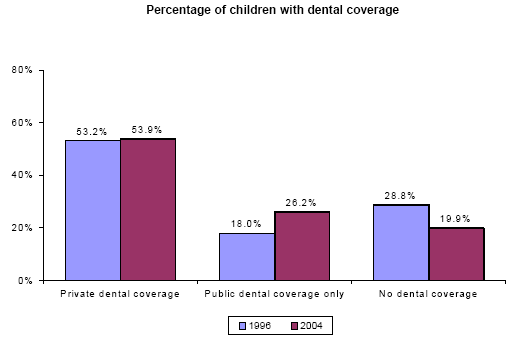
Percentage of children with dental coverage |
| |
1996 |
2004 |
| Private dental coverage |
53.2% |
53.9% |
| Public dental coverage only |
18.0% |
26.2% |
| No dental coverage |
28.8% |
19.9% |
How has distribution of dental coverage changed from 1996 to 2004?
- While no significant changes by age in the percentage of children with private dental coverage from 1996 to 2004 were noted, children of all ages were much more likely to have public dental coverage only and less likely to have no dental coverage in 2004 than in 1996.
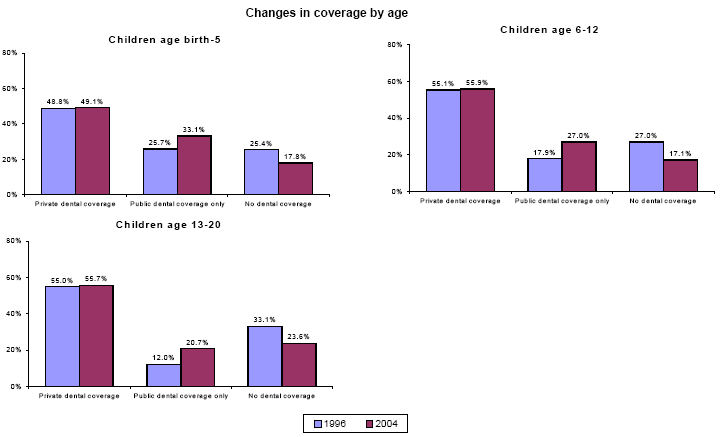
Changes in coverage by age |
|
Children
age birth-5 |
| |
1996 |
2004 |
| Private dental coverage |
48.8% |
49.1% |
| Public dental coverage only |
25.7% |
33.1% |
| No dental coverage |
25.4% |
17.8% |
|
Changes in coverage by age |
|
Children
age 6-12 |
| |
1996 |
2004 |
| Private dental coverage |
55.1% |
55.9% |
| Public dental coverage only |
17.9% |
27.0% |
| No dental coverage |
27.0% |
17.1% |
|
Changes in coverage by age |
|
Children
age 13-20 |
| |
1996 |
2004 |
| Private dental coverage |
55.0% |
55.7% |
| Public dental coverage only |
12.0% |
20.7% |
| No dental coverage |
33.1% |
23.6% |
|
- Poor, low-income, and middle-income children were much more likely to have public dental coverage only and less
likely to have no dental coverage in 2004 than in 1996.
- Low-income and middle-income children were less likely to have private dental coverage in 2004 than in 1996.
- High-income children were more likely to have private dental coverage and less likely to have no dental coverage in 1996 than in 2004.
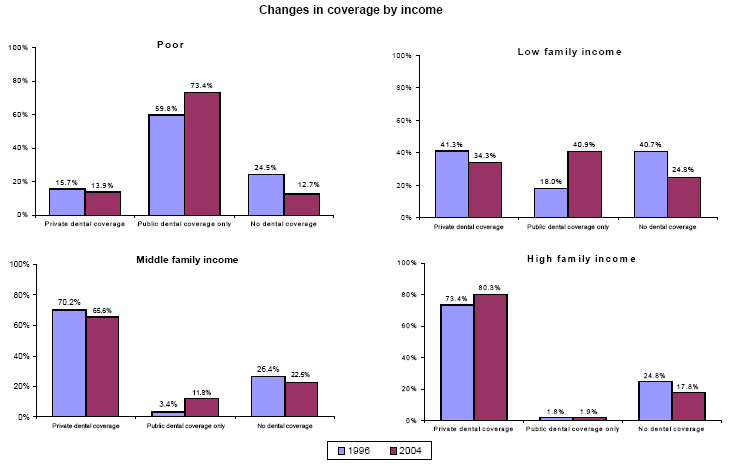
Changes in coverage by income |
|
Poor |
| |
1996 |
2004 |
| Private dental coverage |
15.7% |
13.9% |
| Public dental coverage only |
59.8% |
73.4% |
| No dental coverage |
24.5% |
12.7% |
|
Changes in coverage by income |
|
Low
family income |
| |
1996 |
2004 |
| Private dental coverage |
41.3% |
34.3% |
| Public dental coverage only |
18.0% |
40.9% |
| No dental coverage |
40.7% |
24.8% |
|
Changes in coverage by income |
|
Middle
family income |
| |
1996 |
2004 |
| Private dental coverage |
70.2% |
65.6% |
| Public dental coverage only |
3.4% |
11.8% |
| No dental coverage |
26.4% |
22.5% |
|
Changes in coverage by income |
|
High
family income |
| |
1996 |
2004 |
| Private dental coverage |
73.4% |
80.3% |
| Public dental coverage only |
1.8% |
1.9% |
| No dental coverage |
24.8% |
17.8% |
|
- Black non-Hispanic, white non-Hispanic, and Hispanic children were much more likely to have public dental coverage only and
less likely to have no dental coverage in 2004 than in 1996.
- Children of other race/ethnicity categories were less likely to have no dental coverage in 2004 than in 1996.

Changes in coverage by race/ethnicity |
|
Black
non-Hispanic |
| |
1996 |
2004 |
| Private dental coverage |
39.5% |
43.5% |
| Public dental coverage only |
33.7% |
44.9% |
| No dental coverage |
26.8% |
11.6% |
|
Changes in coverage by race/ethnicity |
|
Hispanic |
| |
1996 |
2004 |
| Private dental coverage |
31.2% |
31.8% |
| Public dental coverage only |
35.0% |
42.9% |
| No dental coverage |
33.9% |
25.3% |
|
Changes in coverage by race/ethnicity |
|
White
non-Hispanic |
| |
1996 |
2004 |
| Private dental coverage |
61.5% |
63.5% |
| Public dental coverage only |
10.1% |
16.2% |
| No dental coverage |
28.4% |
20.3% |
|
Changes in coverage by race/ethnicity |
|
Other* |
| |
1996 |
2004 |
| Private dental coverage |
53.1% |
55.3% |
| Public dental coverage only |
22.3% |
25.4% |
| No dental coverage |
24.5% |
19.3% |
|
*Other includes non-Hispanics who reported to be of single race other than white or black (i.e., American Indian/Alaska Native, Asian, or Native
Hawaiian/Pacific Islander) as well as non-Hispanics who reported to be of multiple races (possibly including black).
- Children with a high school graduate caregiver had a statistically significant decrease in the likelihood of having
private dental coverage from 1996 to 2004.
- Children of caregivers of all levels of education were much more likely to have public dental coverage only and less
likely to have no dental coverage in 2004 than in 1996.
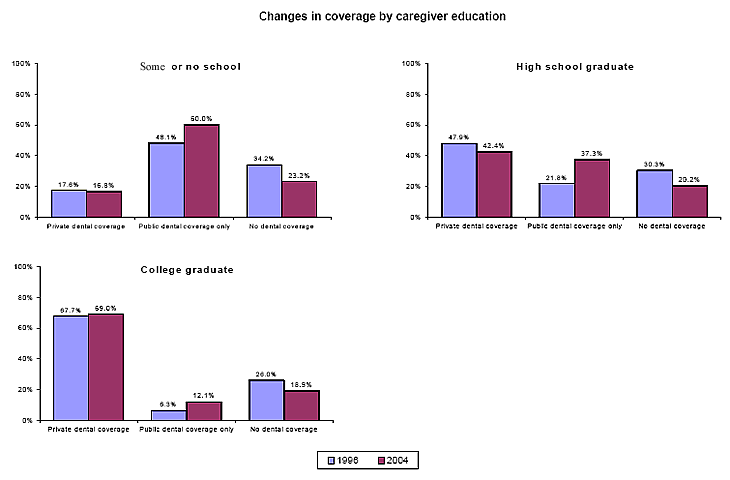
Changes in coverage by caregiver education |
|
Some or
no school |
| |
1996 |
2004 |
| Private dental coverage |
17.6% |
16.8% |
| Public dental coverage only |
48.1% |
60.0% |
| No dental coverage |
34.2% |
23.2% |
|
Changes in coverage by caregiver education |
|
High
school graduate |
| |
1996 |
2004 |
| Private dental coverage |
47.9% |
42.4% |
| Public dental coverage only |
21.8% |
37.3% |
| No dental coverage |
30.3% |
20.2% |
|
Changes in coverage by caregiver education |
|
College
graduate |
| |
1996 |
2004 |
| Private dental coverage |
67.7% |
69.0% |
| Public dental coverage only |
6.3% |
12.1% |
| No dental coverage |
26.0% |
18.9% |
|
Return to Table of Contents
Chapter 3.
Adults: Age 21-64
Section 1: Dental Use
What proportion of adults has a dental visit?
- In 2004, there were about 171 million adults (age 21-64) in the community population of the United States.
- Approximately 43% of the adult population had at least one dental visit during the year.
- The average expense was $556 per year for adults with a dental visit, and the average number of visits was 2.3 visits per adult for adults with a visit (data not shown).
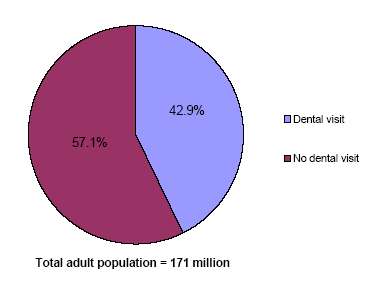
| What proportion of
adults has a dental visit? |
| Dental visit |
42.9% |
| No dental visit |
57.1% |
| Total adult population = 171
million |
What procedures do adults receive?
- In 2004, approximately 73 million adults with at least one dental visit received about 312 million dental procedures in the United States.
- Approximately 86% of the adult population with at least one dental visit had at least one diagnostic procedure
(examination or x-ray), and about 79% of the adult population had at least one preventive procedure (cleaning,
fluoride, or sealant) during the year.
- Together, approximately 74% of all adult procedures were diagnostic (44.6%) or preventive (29.5%) during 2004.
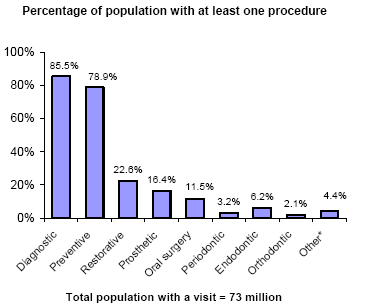
| Percentage of population with at least one procedure |
| Diagnostic |
85.5% |
| Preventive |
78.9% |
| Restorative |
22.6% |
| Prosthetic |
16.4% |
| Oral surgery |
11.5% |
| Periodontic |
3.2% |
| Endodontic |
6.2% |
| Orthodontic |
2.1% |
| Other* |
4.4% |
| Total population with a visit = 73 million |
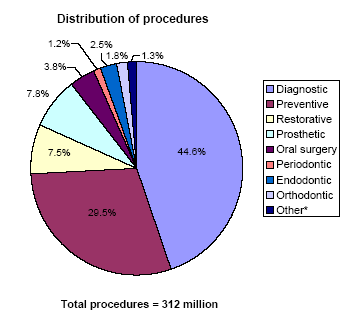
Distribution of procedures |
| Diagnostic |
44.6% |
| Preventive |
29.5% |
| Restorative |
7.5% |
| Prosthetic |
7.8% |
| Oral surgery |
3.8% |
| Periodontic |
1.2% |
| Endodontic |
2.5% |
| Orthodontic |
1.8% |
| Other* |
1.3% |
| Total procedures = 312 million |
*Other includes treatment for TMD or TMJ (jaw pain), and bonding, whiting, or bleaching.
What dental providers do adults visit?
- In 2004, approximately 73 million adults with at least one dental visit made about 170 million visits to a dental office in the United States.
- Approximately 91% of adult dental visits were to a general dentist. While 2.9% of adult dental visits were to an oral
surgeon, 3.4% were to an orthodontist.
- Approximately 3.2% of adult dental visits were to other dental providers including endodontists (dentists who
perform root canals) and periodontists (dentists who treat gums).
- About 36% of all dental visits included care by both a dentist and a non-dentist team member.*
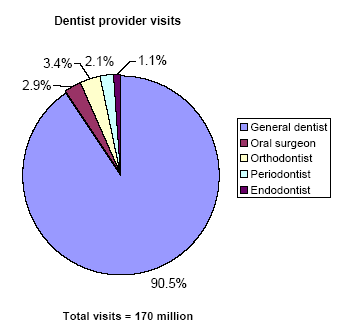
Dentist provider visits |
| General dentist |
90.5% |
| Oral surgeon |
2.9% |
| Orthodontist |
3.4% |
| Periodontist |
2.1% |
| Endodontist |
1.1% |
| Total visits = 170 million |
*Non-dentist team members include dental hygienists, dental technicians, or other non-dentist dental specialists.
How are dental visits distributed across the adult population?
- In 2004, the likelihood of having a dental visit varied by age, family income, race/ethnicity, and education.
- Approximately 39% of adults age 21-44 had at least one dental visit during the year, and 49% of adults age 45-64
had at least one dental visit during the year.
- While 56% of adults from a high-income family had at least one dental visit during the year, only 27% of adults
from a family with low income had at least one dental visit during the year.

Percentage with a dental visit |
|
| 21-44 |
38.7% |
| 45-64 |
48.6% |
|
Percentage with
a dental visit |
|
| Poor |
22.7% |
| Low Income |
26.9% |
| Middle Income |
39.7% |
| High Income |
56.2% |
|
- Black non-Hispanics and Hispanics were less likely to have a dental visit in 2004 than white non-Hispanic adults or
adults of other race/ethnicity categories.
- Adults with less than a high school education were less likely to have a dental visit in 2004 than college graduates.
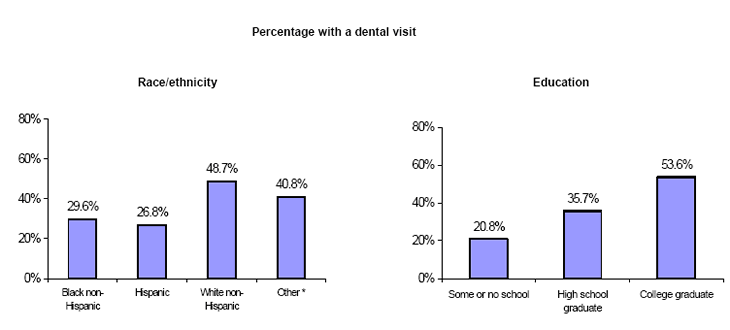
Percentage with a dental visit |
|
Race/ethnicity |
| Black non-Hispanic |
29.6% |
| Hispanic |
26.8% |
| White non-Hispanic |
48.7% |
| Other* |
40.8% |
|
Percentage with
a dental visit |
|
| Some or no school |
20.8% |
| High school graduate |
35.7% |
| College graduate |
53.6% |
|
*Other includes non-Hispanics who reported to be of single race other than white or black (i.e., American Indian/Alaska Native, Asian, or Native
Hawaiian/Pacific Islander) as well as non-Hispanics who reported to be of multiple races (possibly including black).
Return to Table of Contents
Section 2: Dental Coverage
What proportion of adults has dental coverage?
- In 2004, approximately 103 million adults or 60% of the adult community population had private dental coverage during the year.
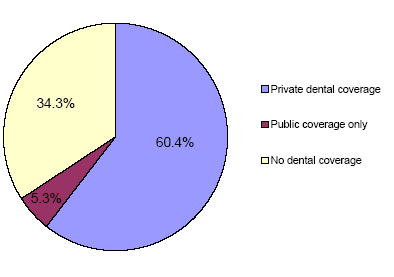
| What proportion of
adults has dental coverage? |
| Private dental insurance |
60.4% |
| Public dental insurance |
5.3% |
| No dental coverage |
34.3% |
How is dental coverage distributed across the adult population?
- In 2004, dental coverage varied by age, family income, race/ethnicity, and education.
- Adults from a family with lower income were less likely to have private dental coverage and more likely to have public coverage.
- Poor adults and adults from a family with low income were more likely to have no dental coverage in 2004 than adults from a
family with middle or high income.
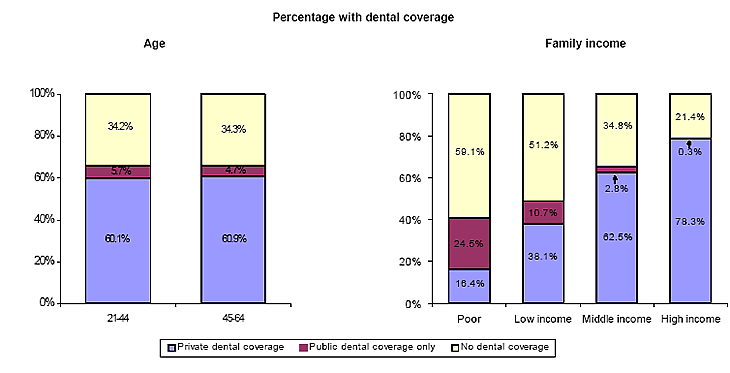
Percentage with dental coverage |
|
| |
Private dental coverage |
Public dental coverage only |
No dental coverage |
| 21-44 |
60.1% |
5.7% |
34.2% |
| 45-64 |
60.9% |
4.7% |
34.3% |
|
Percentage with dental coverage |
|
| |
Private dental coverage |
Public dental coverage only |
No dental coverage |
| Poor |
16.4% |
24.5% |
59.1% |
| Low income |
38.1% |
10.7% |
51.2% |
| Middle income |
62.5% |
2.8% |
34.8% |
| High income |
78.3% |
0.3% |
21.4% |
|
- Black non-Hispanics and Hispanics were more likely to have no dental coverage in 2004 than white non-Hispanic adults
or adults of other race/ethnicity categories.
- Adults with less than a high school education were more likely to have no dental coverage in 2004 than high school
or college graduates.
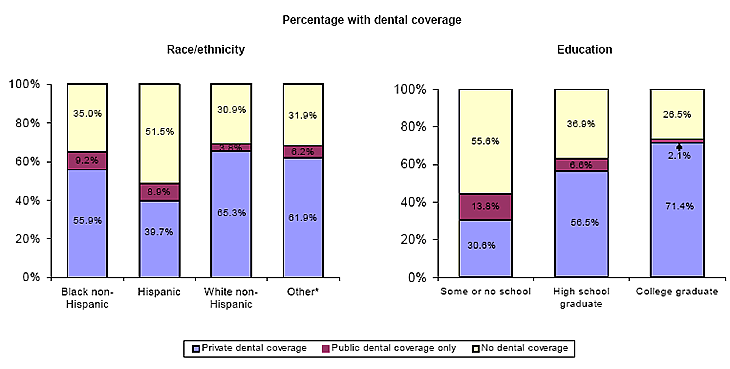
Percentage with dental coverage |
|
| |
Private dental coverage |
Public dental coverage only |
No dental coverage |
| Black non-Hispanic |
55.9% |
9.2% |
35.0% |
| Hispanic |
39.7% |
8.9% |
51.5% |
| White non-Hispanic |
65.3% |
3.8% |
30.9% |
| Other* |
61.9% |
6.2% |
31.9% |
|
Percentage with dental coverage |
|
| |
Private dental coverage |
Public dental coverage only |
No dental coverage |
| Some or no school |
30.6% |
13.8% |
55.6% |
| High school graduate |
56.5% |
6.6% |
36.9% |
| College graduate |
71.4% |
2.1% |
26.5% |
|
*Other includes non-Hispanics who reported to be of single race other than white or black (i.e., American Indian/Alaska Native, Asian, or Native
Hawaiian/Pacific Islander) as well as non-Hispanics who reported to be of multiple races (possibly including black).
Do dental care visits vary by dental coverage status?
- In 2004, 56% of the adult population with private dental coverage had a dental visit, 28% of the adult population with public
dental coverage only had a dental visit, and 22% of adults without any dental coverage had a dental visit.
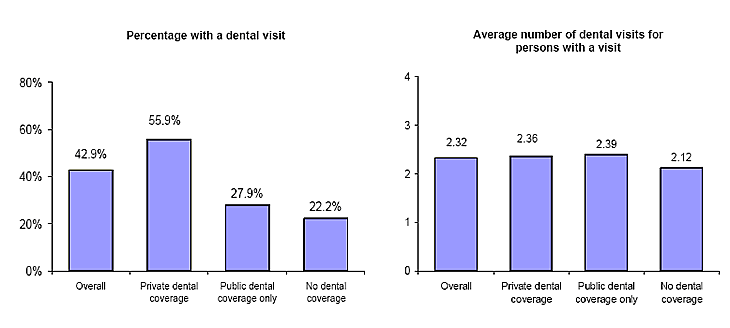
|
Percentage with a dental visit |
| Overall |
42.9% |
| Private dental coverage |
55.9% |
| Public dental coverage only |
27.9% |
| No dental coverage |
22.2% |
|
Average number of dental visits for
persons with a visit |
|
Overall |
2.32 |
| Private dental coverage |
2.36 |
| Public dental coverage only |
2.39 |
| No dental coverage |
2.12 |
|
Do dental care expenses vary by dental coverage status?
- In 2004, total dental expenses for the adult community population of the United States was $41 billion (data not shown).
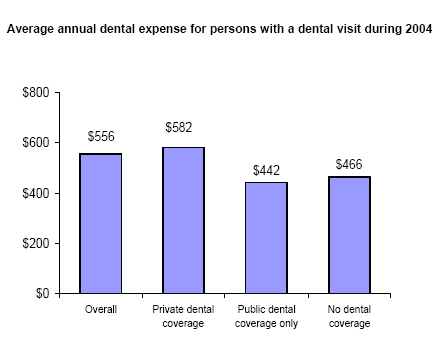
|
Average annual dental expense for
persons with a dental visit during 2004 |
| Overall |
$556 |
| Private dental coverage |
$582 |
| Public dental coverage only |
$442 |
| No dental coverage |
$466 |
Return to Table of Contents
Section 3: Changes from 1996 to 2004
How has the percentage of the adult population with a dental visit changed from 1996 to 2004?
- There was no significant change in the percentage of adults with a dental visit from 1996 to 2004.
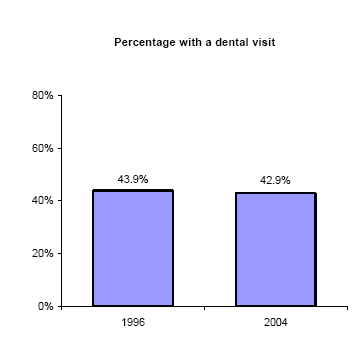
| Percentage with a dental
visit |
| 1996 |
43.9% |
| 2004 |
42.9% |
- Younger and middle-income adults had a significant decrease in the likelihood of having a dental visit from 1996 to 2004.
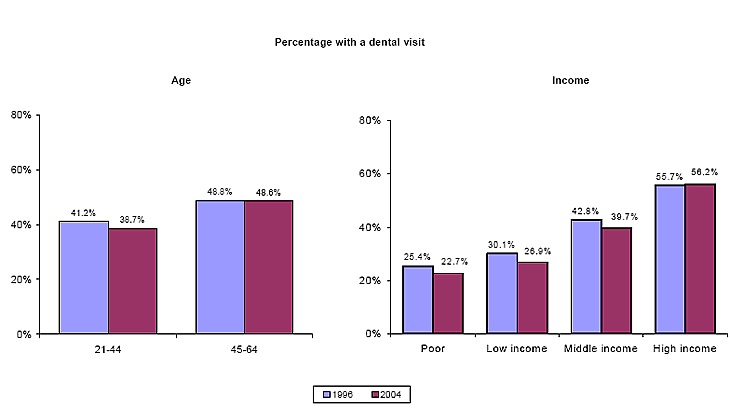
Percentage with a dental visit |
|
| |
1996 |
2004 |
| 21-44 |
41.2% |
38.7% |
| 45-64 |
48.8% |
48.6% |
|
Percentage with a dental visit |
|
| |
1996 |
2004 |
| Poor |
25.4% |
22.7% |
| Low Income |
30.1% |
26.9% |
| Middle Income |
42.8% |
39.7% |
| High Income |
55.7% |
56.2% |
|
- High school graduates had a significant decrease in the likelihood of having a dental visit from 1996 to 2004.
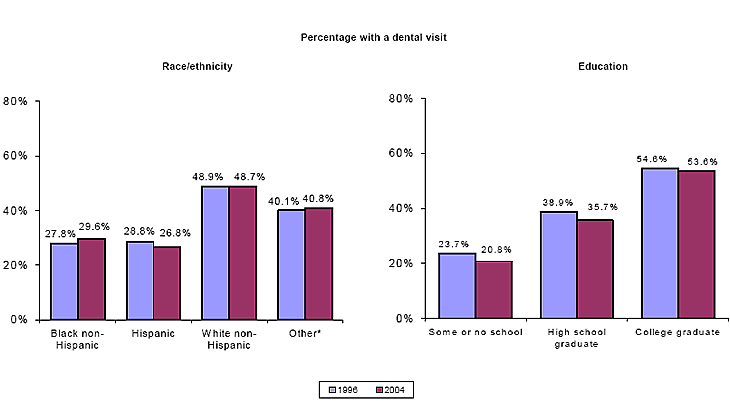
Percentage with
a dental visit |
|
| |
1996 |
2004 |
| Black non-Hispanic |
27.8% |
29.6% |
| Hispanic |
28.8% |
26.8% |
| White non-Hispanic |
48.9% |
48.7% |
| Other* |
40.1% |
40.8% |
|
Percentage with
a dental visit |
|
| |
1996 |
2004 |
| Some or no school |
23.7% |
20.8% |
| High school graduate |
38.9% |
35.7% |
| College graduate |
54.6% |
53.6% |
|
*Other includes non-Hispanics who reported to be of single race other than white or black (i.e., American Indian/Alaska Native, Asian, or Native
Hawaiian/Pacific Islander) as well as non-Hispanics who reported to be of multiple races (possibly including black).
- Adults without dental coverage had a statistically significant decrease in the likelihood of having a dental visit from 1996 to 2004.
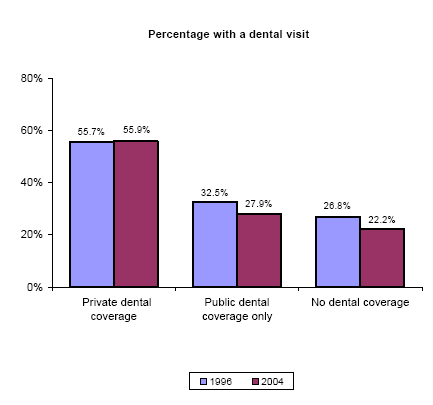
Percentage with a dental visit |
| |
1996 |
2004 |
| Private dental coverage |
55.7% |
55.9% |
| Public dental coverage only |
32.5% |
27.9% |
| No dental coverage |
26.8% |
22.2% |
|
How have dental visits and dental expenses changed
from 1996 to 2004?
- There was no statistically significant change in the average
number of dental visits per adult for those with a dental
visit from 1996 to 2004.
- Average dental expenses increased from $361 ($434 adjusted for inflation) in 1996 to $556 in 2004.
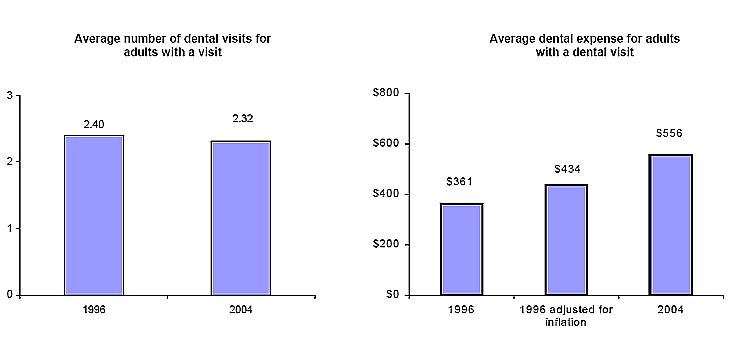
Average number of dental visits for
adults with a visit |
| 1996 |
2.40 |
| 2004 |
2.32 |
|
Average dental expense for adults
with a dental visit |
| 1996 |
$361 |
| 1996 adjusted for
inflation |
$434 |
| 2004 |
$556 |
|
How have average visits per adult for those with a dental visit changed from 1996 to 2004?
- Adults age 45-64 and adults in the low- or middle-income category had a significant decrease in the number of dental visits per year from 1996 to 2004.
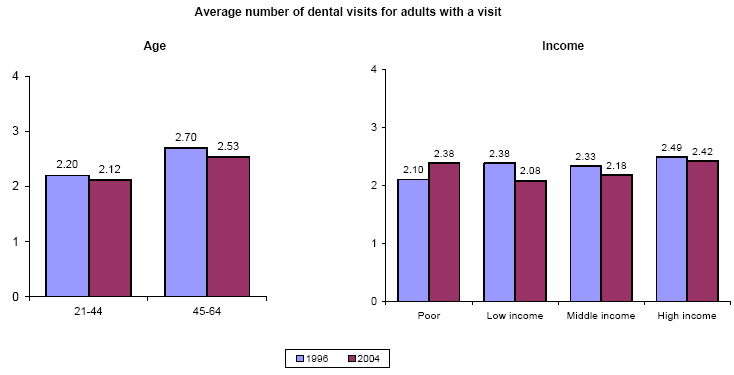
Average number of dental visits
for adults with a visit |
|
| |
1996 |
2004 |
| 21-44 |
2.20 |
2.12 |
| 45-64 |
2.70 |
2.53 |
|
Average number of dental visits
for adults with a visit |
|
| |
1996 |
2004 |
| Poor |
2.10 |
2.38 |
| Low Income |
2.38 |
2.08 |
| Middle Income |
2.33 |
2.18 |
| High Income |
2.49 |
2.42 |
|
- There was no statistically significant change in the average number of dental visits per adult for those with a dental visit from 1996 to 2004, when considered by race/ethnicity or by educational attainment.
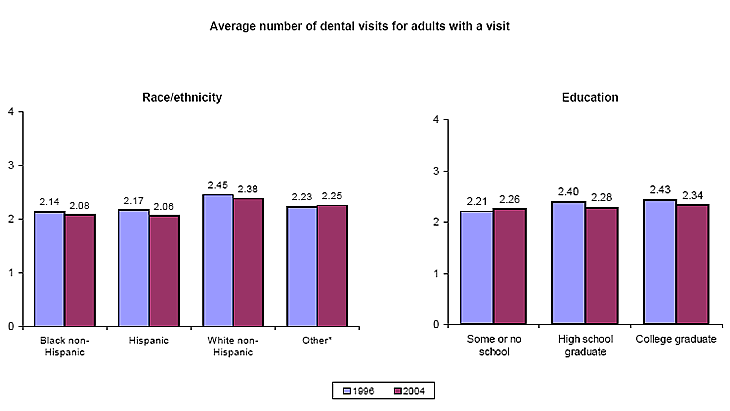
Average number of dental visits
for adults with a visit |
|
| |
1996 |
2004 |
| Black non-Hispanic |
2.14 |
2.08 |
| Hispanic |
2.17 |
2.06 |
| White non-Hispanic |
2.45 |
2.38 |
| Other* |
2.23 |
2.25 |
|
Average number of dental visits
for adults with a visit |
|
| |
1996 |
2004 |
| Some or no school |
2.21 |
2.26 |
| High school graduate |
2.40 |
2.28 |
| College graduate |
2.43 |
2.34 |
|
*Other includes non-Hispanics who reported to be of single race other than white or black (i.e., American Indian/Alaska Native, Asian, or Native
Hawaiian/Pacific Islander) as well as non-Hispanics who reported to be of multiple races (possibly including black).
- Adults with private dental coverage had a significant decrease in the number of dental visits per year from 1996 to 2004.

Average number of dental visits for adults
with a visit |
| |
1996 |
2004 |
| Private dental coverage |
2.47 |
2.36 |
| Public dental coverage only |
2.24 |
2.39 |
| No dental coverage |
2.19 |
2.12 |
|
How has the average dental expense for those with a dental visit changed from 1996 to 2004?
- For each age and income category, the average expense (adjusted for inflation) increased from 1996 to 2004.
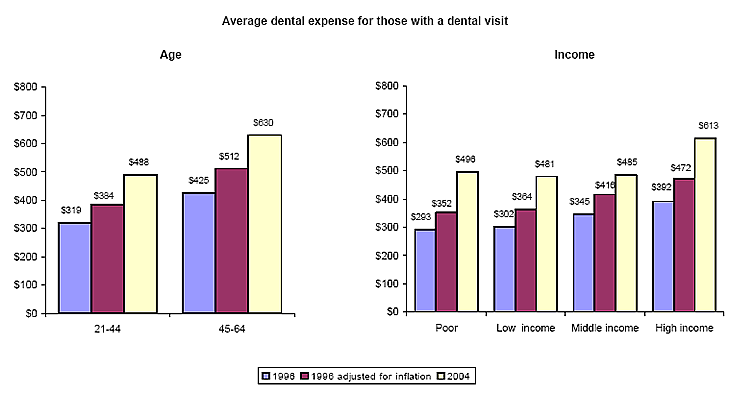
Average dental expense for those with a
dental visit |
|
| |
1996 |
1996 adjusted for inflation |
2004 |
| 21-44 |
$319 |
$384 |
$488 |
| 45-64 |
$425 |
$512 |
$630 |
|
Average dental expense for those with a
dental visit |
|
| |
1996 |
1996 adjusted for inflation |
2004 |
| Poor |
$293 |
$352 |
$496 |
| Low income |
$302 |
$364 |
$481 |
| Middle income |
$345 |
$416 |
$485 |
| High income |
$392 |
$472 |
$613 |
|
- While black non-Hispanic and Hispanic adults and adults
of other race/ethnicity categories did not have a statistically significant increase in expenses (adjusted for inflation) from 1996 to 2004, white non-Hispanic adults did.
- For each education category, the average expense (adjusted for inflation) increased from 1996 to 2004.
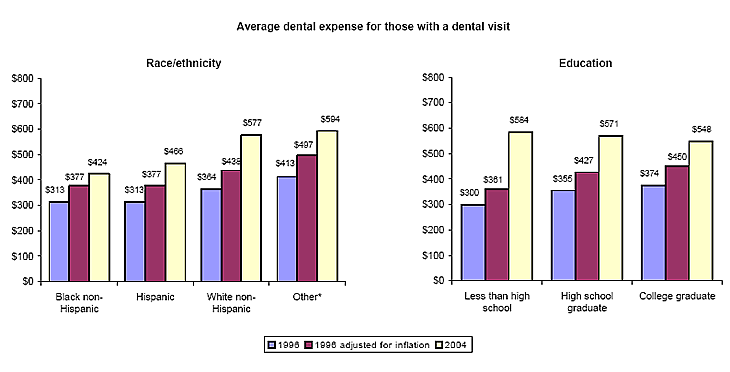
Average dental expense for those with a
dental visit |
|
| |
1996 |
1996 adjusted for inflation |
2004 |
| Black Non-Hispanic |
$313 |
$377 |
$424 |
| Hispanic |
$313 |
$377 |
$466 |
| White Non-Hispanic |
$364 |
$438 |
$577 |
| Other* |
$413 |
$497 |
$594 |
|
Average dental expense for those with a
dental visit |
|
| |
1996 |
1996 adjusted for inflation |
2004 |
| Less than high school |
$300 |
$361 |
$584 |
| High school graduate |
$355 |
$427 |
$571 |
| College graduate |
$374 |
$450 |
$548 |
|
*Other includes non-Hispanics who reported to be of single race other than white or black (i.e., American Indian/Alaska Native, Asian, or Native
Hawaiian/Pacific Islander) as well as non-Hispanics who reported to be of multiple races (possibly including black).
- For adults with private or no dental coverage, the average
expense (adjusted for inflation) increased from 1996 to
2004.
- No significant change (adjusted for inflation) was observed for adults with public dental coverage only from 1996 to
2004.
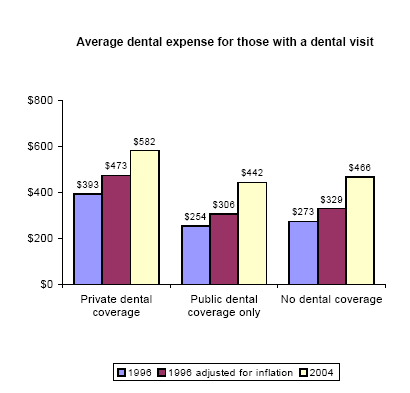
Average dental expense for those with a dental visit |
| |
1996 |
1996 adjusted for inflation |
2004 |
| Private dental coverage |
$393 |
$473 |
$582 |
| Public dental coverage only |
$254 |
$306 |
$442 |
| No dental coverage |
$273 |
$329 |
$466 |
How has the likelihood of having at least one type of procedure
changed from 1996 to 2004?
- Adults were more likely to have at least one diagnostic, preventive, or orthodontic procedure and less likely to have at least one restorative or oral surgery procedure in 2004 than in 1996.
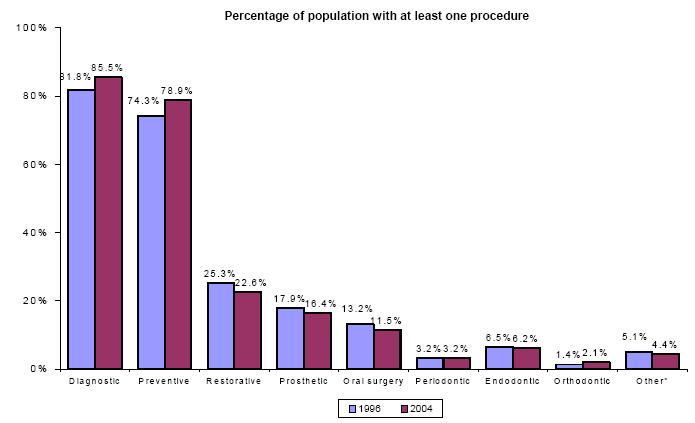
| Percentage of population
with at least one procedure |
| |
1996 |
2004 |
| Diagnostic |
81.8% |
85.5% |
| Preventive |
74.3% |
78.9% |
| Restorative |
25.3% |
22.6% |
| Prosthetic |
17.9% |
16.4% |
| Oral surgery |
13.2% |
11.5% |
| Periodontic |
3.2% |
3.2% |
| Endodontic |
6.5% |
6.2% |
| Orthodontic |
1.4% |
2.1% |
| Other* |
5.1% |
4.4% |
*Other includes treatment for TMD or TMJ (jaw pain), bonding, whiting, or bleaching.
How has the distribution of procedures changed
from 1996 to 2004?
- The total number of procedures increased from about 276 million in 1996 to about 312 million in 2004 (data not
shown).
- As a percentage of all procedures, from 1996 to 2004 diagnostic procedures increased while restorative, prosthetic,
oral surgery, and other procedure types decreased.
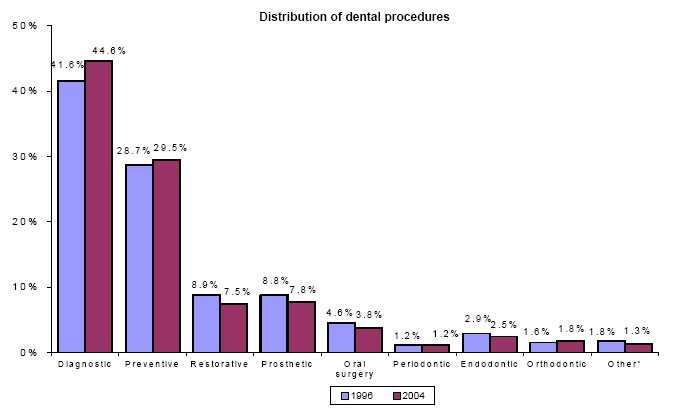
| Distribution of dental
procedures |
| |
1996 |
2004 |
| Diagnostic |
41.6% |
44.6% |
| Preventive |
28.7% |
29.5% |
| Restorative |
8.9% |
7.5% |
| Prosthetic |
8.8% |
7.8% |
| Oral surgery |
4.6% |
3.8% |
| Periodontic |
1.2% |
1.2% |
| Endodontic |
2.9% |
2.5% |
| Orthodontic |
1.6% |
1.8% |
| Other* |
1.8% |
1.3% |
*Other includes treatment for TMD or TMJ (jaw pain), bonding, whiting, or bleaching.
How have dental expenses changed from 1996 to 2004 by category of procedure?
- Average dental expenses increased from $115 ($138 adjusted for inflation) in 1996 to $181 and $142 ($171 adjusted for inflation)
in 1996 to $225 for preventive/diagnostic procedures and restorative procedures, respectively, in 2004.
- Expenses for other dental procedures (periodontic, orthodontic, prosthetic, endodontic, and oral surgery) increased from $239
($288 adjusted for inflation) in 1996 to $411 ($288 adjusted for inflation) in 2004.

| Average dental expense for adults per visit by procedure category |
| |
1996 |
1996 adjusted for inflation |
2004 |
| Overall |
$151 |
$181 |
$241 |
| Preventive/Diagnostic |
$115 |
$138 |
$181 |
| Restorative |
$142 |
$171 |
$225 |
| Other* |
$239 |
$288 |
$411 |
*Other includes periodontic (gums), orthodontic (braces), prosthetic (crown, bridges, and dentures), endodontic (root canals), oral surgery, treatment for
TMD or TMJ (jaw pain), and bonding, whiting, or bleaching.
How has the percentage of adults with dental coverage
changed from 1996 to 2004?
- The percentage of adults with private dental coverage increased from 58% in 1996 to 60% in 2004. There was a decrease in the percentage of adults with no dental coverage from 1996 to 2004.
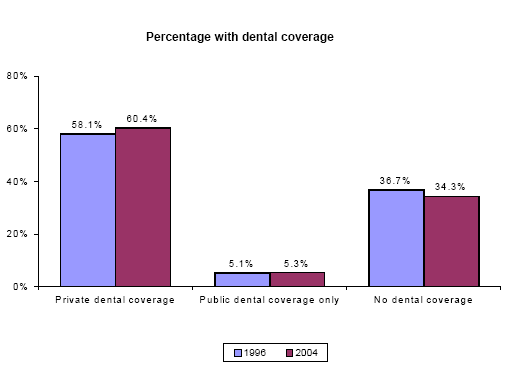
Percentage with dental coverage |
| |
1996 |
2004 |
| Private dental coverage |
58.1% |
60.4% |
| Public dental coverage only |
5.1% |
5.3% |
| No dental coverage |
36.7% |
34.3% |
How has distribution of dental coverage changed from 1996 to 2004?
- There was a decrease in the percentage of adults age 45-64 with no dental coverage from 1996 to 2004.
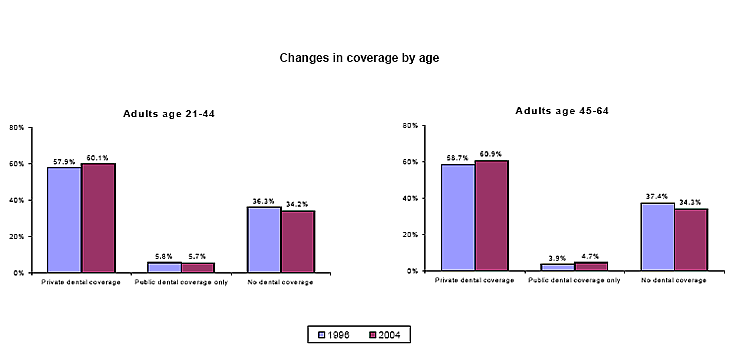
Changes in coverage by age |
|
Adults
age 21-44 |
| |
1996 |
2004 |
| Private dental coverage |
57.9% |
60.1% |
| Public dental coverage only |
5.8% |
5.7% |
| No dental coverage |
36.3% |
34.2% |
|
Changes in coverage by age |
|
Adults
age 45-64 |
| |
1996 |
2004 |
| Private dental coverage |
58.7% |
60.9% |
| Public dental coverage only |
3.9% |
4.7% |
| No dental coverage |
37.4% |
34.3% |
|
- Low- and middle-income adults had an increase in public dental coverage only from 1996 to 2004.
- High-income adults had a significant increase in private dental coverage and a decrease in no dental coverage from 1996 to 2004.
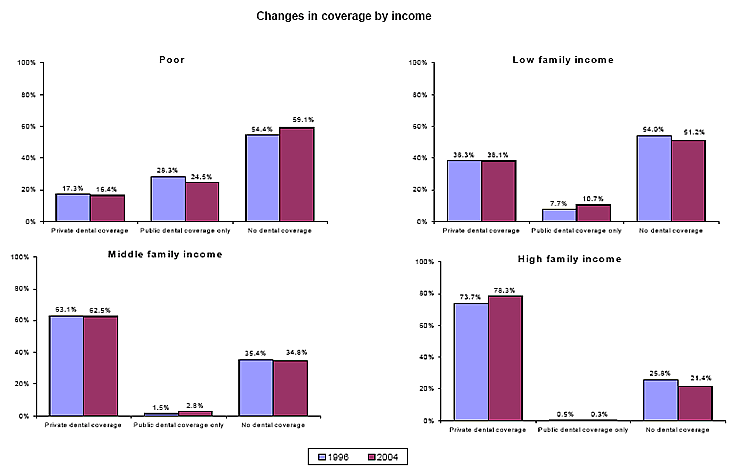
Changes in coverage by income |
|
Poor |
| |
1996 |
2004 |
| Private dental coverage |
17.3% |
16.4% |
| Public dental coverage only |
28.3% |
24.5% |
| No dental coverage |
54.4% |
59.1% |
|
Changes in coverage by income |
|
Low
family income |
| |
1996 |
2004 |
| Private dental coverage |
38.3% |
38.1% |
| Public dental coverage only |
7.7% |
10.7% |
| No dental coverage |
54.0% |
51.2% |
|
Changes in coverage by income |
|
Middle
family income |
| |
1996 |
2004 |
| Private dental coverage |
63.1% |
62.5% |
| Public dental coverage only |
1.5% |
2.8% |
| No dental coverage |
35.4% |
34.8% |
|
Changes in coverage by income |
|
High
family income |
| |
1996 |
2004 |
| Private dental coverage |
73.7% |
78.3% |
| Public dental coverage only |
0.5% |
0.3% |
| No dental coverage |
25.8% |
21.4% |
|
- No change is noted for Hispanics or black non-Hispanics and adults of other race categories, regardless of the type of dental coverage.
- White non-Hispanic adults had an increase in private dental coverage and a decrease in no dental coverage from 1996 to 2004.
-
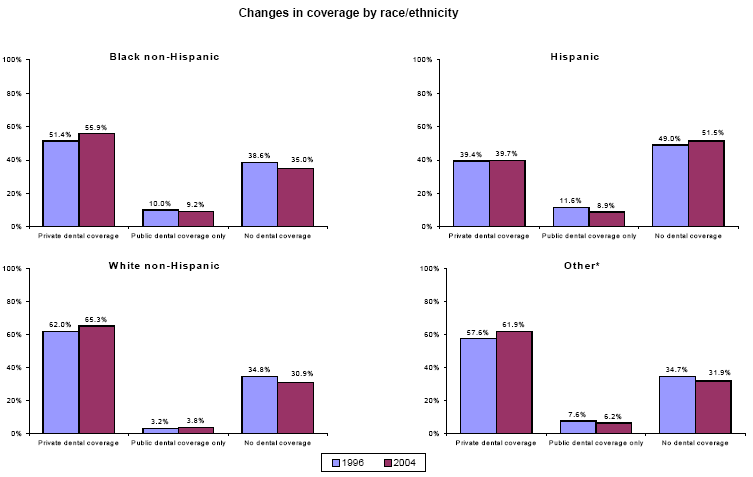
Changes in coverage by race/ethnicity |
|
Black
non-Hispanic |
| |
1996 |
2004 |
| Private dental coverage |
51.4% |
55.9% |
| Public dental coverage only |
10.0% |
9.2% |
| No dental coverage |
38.6% |
35.0% |
|
Changes in coverage by race/ethnicity |
|
Hispanic |
| |
1996 |
2004 |
| Private dental coverage |
39.4% |
39.7% |
| Public dental coverage only |
11.6% |
8.9% |
| No dental coverage |
49.0% |
51.5% |
|
Changes in coverage by race/ethnicity |
|
White
non-Hispanic |
| |
1996 |
2004 |
| Private dental coverage |
62.0% |
65.3% |
| Public dental coverage only |
3.2% |
3.8% |
| No dental coverage |
34.8% |
30.9% |
|
Changes in coverage by race/ethnicity |
|
Other* |
| |
1996 |
2004 |
| Private dental coverage |
57.6% |
61.9% |
| Public dental coverage only |
7.6% |
6.2% |
| No dental coverage |
34.7% |
31.9% |
|
*Other includes non-Hispanics who reported to be of single race other than white or black (i.e., American Indian/Alaska Native, Asian, or Native
Hawaiian/Pacific Islander) as well as non-Hispanics who reported to be of multiple races (possibly including black).
- There were no significant changes by education in the percentage of adults with private dental coverage from 1996 to 2004.

Changes in coverage by education |
|
School or
no school |
| |
1996 |
2004 |
| Private dental coverage |
29.6% |
30.6% |
| Public dental coverage only |
14.1% |
13.8% |
| No dental coverage |
56.4% |
55.6% |
|
Changes in coverage by education |
|
High
school graduate |
| |
1996 |
2004 |
| Private dental coverage |
55.6% |
56.5% |
| Public dental coverage only |
5.4% |
6.6% |
| No dental coverage |
39.0% |
36.9% |
|
Changes in coverage by education |
|
College
graduate |
| |
1996 |
2004 |
| Private dental coverage |
70.1% |
71.4% |
| Public dental coverage only |
1.8% |
2.1% |
| No dental coverage |
28.2% |
26.5% |
|
Return to Table of Contents
Chapter 4.
Older Adults: Age 65 and Over
Section 1: Dental Use
What proportion of the older adult population has a dental visit?
- In 2004, there were about 37 million older adults in the community population of the United States.
- Approximately 43% of the older adult population had at least one dental visit during the year.
- The average expense was $620 per year for older adults
with a dental visit, and the average number of visits was 2.7 visits per older adult for older adults with a visit (data not shown).
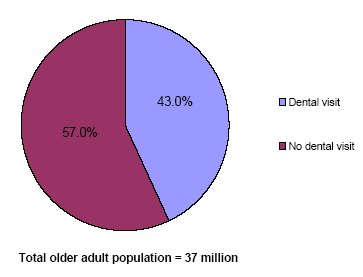
| What proportion of
the older adult population has a dental visit? |
| Dental visit |
43.0% |
| No dental visit |
57.0% |
| Total older adult population = 37
million |
What procedures do older adults receive?
- In 2004, approximately 16 million older adults with at least one dental visit received about 74 million dental procedures in the United States.
- Approximately 82% of the older adult population receiving at least one dental visit had at least one diagnostic
procedure (examination or x-ray), and about 75% of the older adult population had at least one preventive procedure (cleaning, fluoride, or sealant) during the year.
- Together, approximately 70% of all procedures were diagnostic (42.0%) or preventive (27.5%) during 2004.

| Percentage of population with at least one procedure |
| Diagnostic |
82.2% |
| Preventive |
74.7% |
| Restorative |
24.5% |
| Prosthetic |
29.7% |
| Oral surgery |
13.7% |
| Other* |
11.8% |
| Total population with a visit = 16 million |
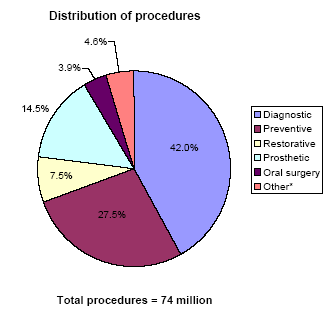
Distribution of procedures |
| Diagnostic |
42.0% |
| Preventive |
27.5% |
| Restorative |
7.5% |
| Prosthetic |
14.5% |
| Oral surgery |
3.9% |
| Other* |
4.6% |
| Total procedures = 74 million |
*Other includes periodontic (gums), endodontic (root canals), orthodontic (braces), treatment for TMD or TMJ (jaw pain), and bonding, whiting, or
bleaching.
What dental providers do older adults visit?
- In 2004, approximately 16 million older adults with at least one dental visit made about 43 million visits to a dental
office in the United States.
- Approximately 91% of older adult dental visits were to a general dentist.
- While 3.6% of older adult dental visits were to an oral surgeon, 5.1% were to other dental providers including
endodontists (dentists who perform root canals), periodontists (dentists who treat gums), or orthodontists
(dentists who correct improper bites).
- About 36% of all dental visits included care by both a dentist and a non-dentist team member.*
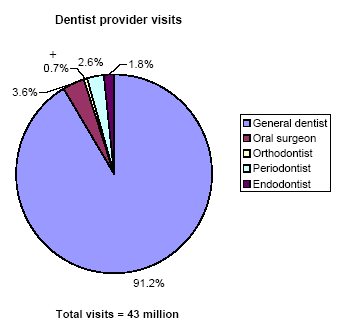
Dentist provider visits |
| General dentist |
91.2% |
| Oral surgeon |
3.6% |
| Orthodontist |
0.7%+ |
| Periodontist |
2.6% |
| Endodontist |
1.8% |
| Total visits = 43 million |
*Non-dentist team members include dental hygienists, dental technicians, or other non-dentist dental specialists.
+Relative standard error greater than 30%
How are dental visits distributed across the older adult population?
- In 2004, the likelihood of having a dental visit varied by age, family income, race/ethnicity, and education.
- Approximately 46% of older adults age 65-74 and 39% of older adults age 75 and over had at least one dental visit during the year.
- While 60% of older adults from a high-income family had at least one dental visit during the year, less than 31% of
older adults from a poor- or low-income family had at least
one dental visit during the year.
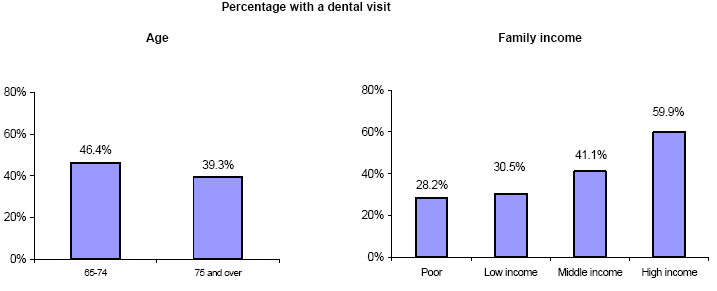
Percentage with a dental visit |
|
| 65-74 |
46.4% |
| 75 and over |
39.3% |
|
Percentage with
a dental visit |
|
| Poor |
28.2% |
| Low Income |
30.5% |
| Middle Income |
41.1% |
| High Income |
59.9% |
|
- Black non-Hispanics and Hispanics were less likely to have a dental visit in 2004 than white non-Hispanic older adults or older adults of other race/ethnicity categories.
- Adults with less than a high school education were less likely to have a dental visit in 2004 than college graduates.
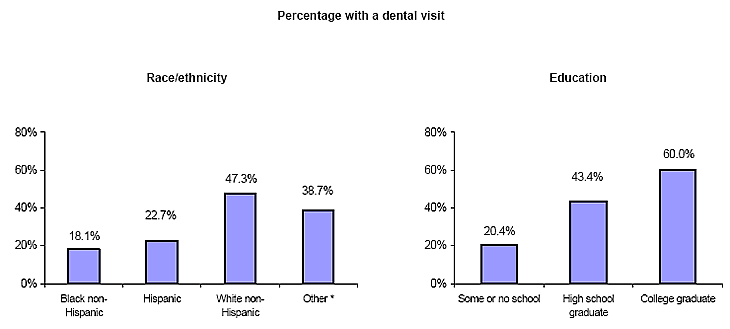
Percentage with a dental visit |
|
Race/ethnicity |
| Black non-Hispanic |
18.1% |
| Hispanic |
22.7% |
| White non-Hispanic |
47.3% |
| Other |
38.7% |
|
Percentage with
a dental visit |
|
| Some or no school |
20.4% |
| High school graduate |
43.4% |
| College graduate |
60.0% |
|
*Other includes non-Hispanics who reported to be of single race other than white or black (i.e., American Indian/Alaska Native, Asian, or Native
Hawaiian/Pacific Islander) as well as non-Hispanics who reported to be of multiple races (possibly including black).
Return to Table of Contents
Section 2: Dental Coverage
What proportion of older adults has dental coverage?
- In 2004, approximately 9 million older adults or 24% of the older adult community population had private dental
coverage during the year.
- Approximately 70% of all older adults did not have any dental coverage.

| What proportion of
older adults has dental coverage? |
| Private dental insurance |
23.8% |
| Public dental insurance |
6.3% |
| No dental coverage |
69.9% |
How is dental coverage distributed across the older adult population?
- In 2004, dental coverage varied by age, family income, race/ethnicity and education.
- About 29% of 65-74 year olds and 18% of older adults age 75 and over had private dental coverage during 2004.
- Older adults from a poor family or from a family with low or middle income were less likely to have private dental
coverage and more likely to have no dental coverage in 2004 than older adults from a family with higher income.
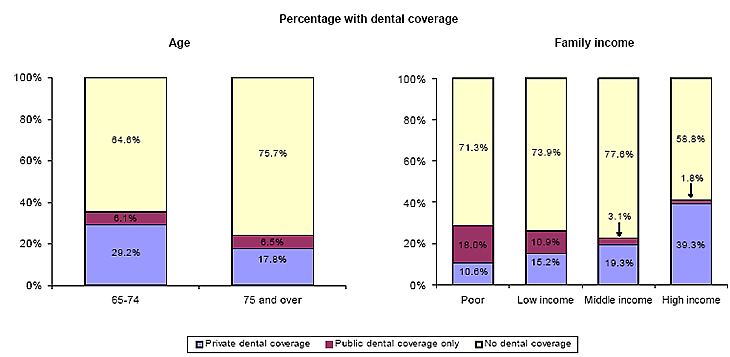
Percentage with dental coverage |
|
| |
Private dental coverage |
Public dental coverage only |
No dental coverage |
| 65-74 |
29.2% |
6.1% |
64.6% |
| 75 and over |
17.8% |
6.5% |
75.7% |
|
Percentage with dental coverage |
|
| |
Private dental coverage |
Public dental coverage only |
No dental coverage |
| Poor |
10.6% |
18.0% |
71.3% |
| Low income |
15.2% |
10.9% |
73.9% |
| Middle income |
19.3% |
3.1% |
77.6% |
| High income |
39.3% |
1.8% |
58.8% |
|
- Hispanic older adults were less likely to have private dental coverage in 2004 than black non-Hispanic older adults or white non-Hispanic older adults.
- Older adults with less than a high school education were less likely to have private dental coverage in 2004 than
college graduates.

Percentage with dental coverage |
|
| |
Private dental coverage |
Public dental coverage only |
No dental coverage |
| Black non-Hispanic |
22.5% |
12.6% |
64.9% |
| Hispanic |
16.0% |
18.3% |
65.7% |
| White non-Hispanic |
25.2% |
3.4% |
71.4% |
| Other* |
10.8% |
31.1% |
58.1% |
|
Percentage with dental coverage |
|
| |
Private dental coverage |
Public dental coverage only |
No dental coverage |
| Some or no school |
12.0% |
13.6% |
74.4% |
| High school graduate |
23.0% |
3.8% |
73.2% |
| College graduate |
33.6% |
3.0% |
63.4% |
|
*Other includes non-Hispanics who reported to be of single race other than white or black (i.e., American Indian/Alaska Native, Asian, or Native
Hawaiian/Pacific Islander) as well as non-Hispanics who reported to be of multiple races (possibly including black).
Do dental care visits vary by dental coverage status?
- In 2004, while 65% of the older adult population with private dental coverage had a dental visit, 26% of the older adult population with public dental coverage only had a dental visit and 37% of the older adult population without any dental coverage had a dental visit.
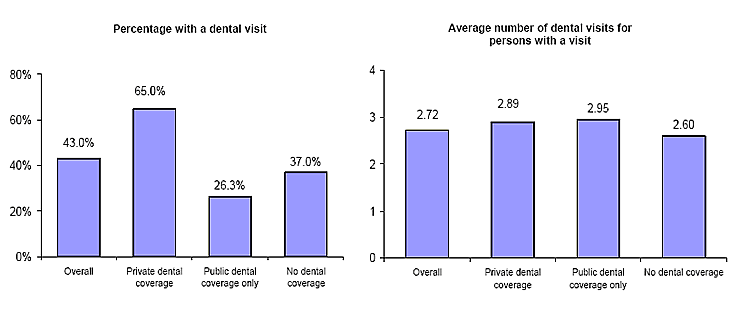
|
Percentage with a dental visit |
| Overall |
43.0% |
| Private dental coverage |
65.0% |
| Public dental coverage only |
26.3% |
| No dental coverage |
37.0% |
|
Average number of dental visits for
persons with a visit |
|
Overall |
2.72 |
| Private dental coverage |
2.89 |
| Public dental coverage only |
2.95 |
| No dental coverage |
2.60 |
|
Do dental care expenses vary by dental coverage status?
- In 2004, the total dental expense for the older adult community population of the United States was $10 billion
(data not shown).
- The average annual expense was $620 for older adults with a dental visit during 2004.
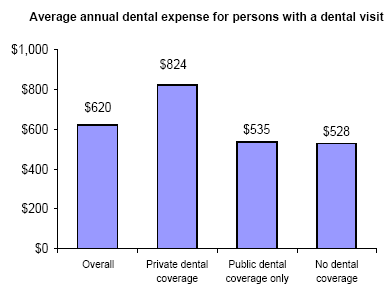
|
Average annual dental expense for
persons with a dental visit |
| Overall |
$620 |
| Private dental coverage |
$824 |
| Public dental coverage only |
$535 |
| No dental coverage |
$528 |
Return to Table of Contents
Section 3: Changes from 1996 to 2004
How has the percentage of the older adult population with a dental visit changed from 1996 to 2004?
- There was no significant change in the percentage of the older adult population with a dental visit from 1996 to 2004.
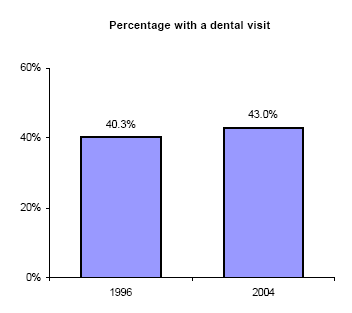
| Percentage with a dental
visit |
| 1996 |
40.3% |
| 2004 |
43.0% |
- Adults age 75 and older were more likely to have a dental visit in 2004 than in 1996.
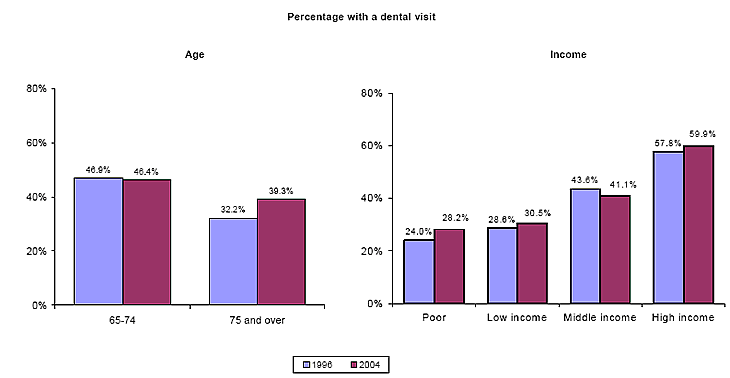
Percentage with a dental visit |
|
| |
1996 |
2004 |
| 65-74 |
46.9% |
46.4% |
| 75 and over |
32.2% |
39.3% |
|
Percentage with a dental visit |
|
| |
1996 |
2004 |
| Poor |
24.0% |
28.2% |
| Low Income |
28.6% |
30.5% |
| Middle Income |
43.6% |
41.1% |
| High Income |
57.8% |
59.9% |
|
- No significant changes by race/ethnicity or education in the percentage of older adults with a dental visit from 1996 to 2004 were
noted.

Percentage with
a dental visit |
|
| |
1996 |
2004 |
| Black non-Hispanic |
16.7% |
18.0% |
| Hispanic |
25.1% |
22.7% |
| White non-Hispanic |
43.6% |
47.3% |
| Other* |
31.8% |
38.7% |
|
Percentage with
a dental visit |
|
| |
1996 |
2004 |
| Some or no school |
23.7% |
20.4% |
| High school graduate |
45.2% |
43.4% |
| College graduate |
61.4% |
60.0% |
|
*Other includes non-Hispanics who reported to be of single race other than white or black (i.e., American Indian/Alaska Native, Asian, or Native
Hawaiian/Pacific Islander) as well as non-Hispanics who reported to be of multiple races (possibly including black).
- Older adults with public dental coverage only were more likely to have a dental visit in 2004 than in 1996.
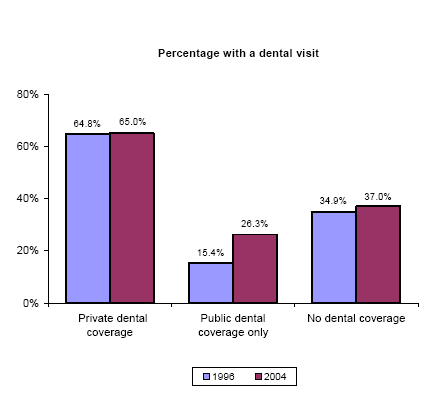
Percentage with dental coverage |
| |
1996 |
2004 |
| Private dental coverage |
64.8% |
65.0% |
| Public dental coverage only |
15.4% |
26.3% |
| No dental coverage |
34.9% |
37.0% |
How have dental visits and dental expenses changed from 1996 to 2004?
- There was no statistically significant change in the average number of dental visits per older adult for those with a
dental visit from 1996 to 2004.
- Average dental expenses increased from $438 ($527 adjusted for inflation) in 1996 to $620 in 2004.
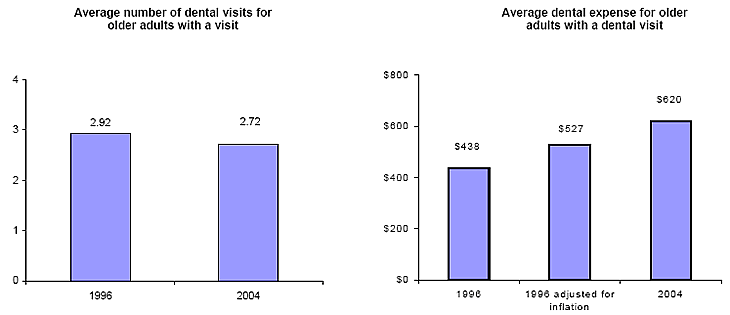
Average number of dental visits for
older adults with a visit |
| 1996 |
2.92 |
| 2004 |
2.72 |
|
Average dental expense for older
adults with a dental visit |
| 1996 |
$438 |
| 1996 adjusted for
inflation |
$527 |
| 2004 |
$620 |
|
How have average visits per older adult for those with a dental visit changed from 1996 to 2004?
- There were no statistically significant changes by age or income in the number of visits by older adults with a dental visit from 1996 to 2004.
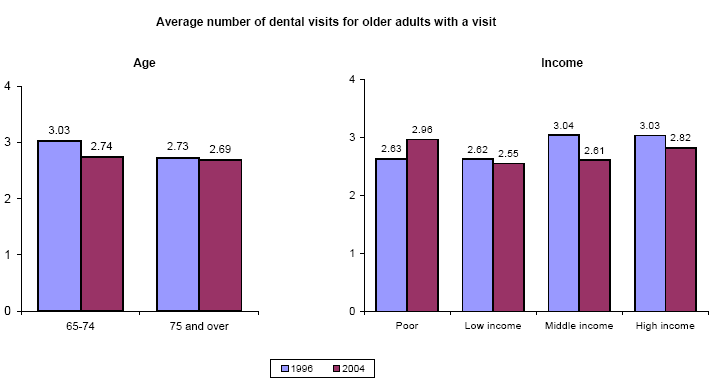
Average number of dental visits
for older adults with a visit |
|
| |
1996 |
2004 |
| 65-74 |
3.03 |
2.74 |
| 75 and over |
2.73 |
2.69 |
|
Average number of dental visits
for older adults with a visit |
|
| |
1996 |
2004 |
| Poor |
2.63 |
2.96 |
| Low Income |
2.62 |
2.55 |
| Middle Income |
3.04 |
2.61 |
| High Income |
3.03 |
2.82 |
|
- No significant changes by race/ethnicity or education in the average number of visits for older adults with a dental visit from 1996 to 2004 were noted.
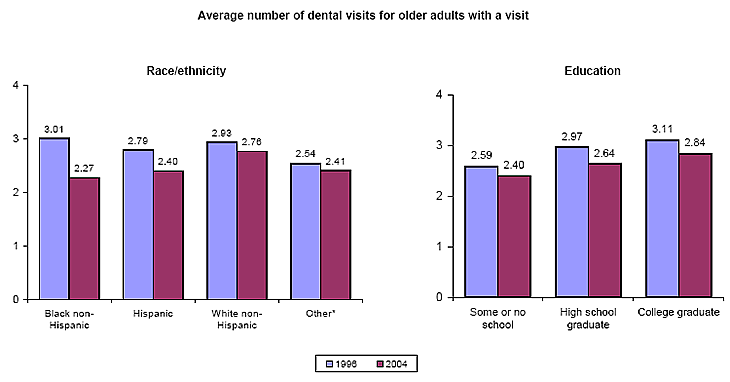
Average number of dental visits
for older adults with a visit |
|
| |
1996 |
2004 |
| Black non-Hispanic |
3.01 |
2.27 |
| Hispanic |
2.79 |
2.40 |
| White non-Hispanic |
2.93 |
2.76 |
| Other* |
2.54 |
2.41 |
|
Average number of dental visits
for older adults with a visit |
|
| |
1996 |
2004 |
| Some or no school |
2.59 |
2.40 |
| High school graduate |
2.97 |
2.64 |
| College graduate |
3.11 |
2.84 |
|
*Other includes non-Hispanics who reported to be of single race other than white or black (i.e., American Indian/Alaska Native, Asian, or Native
Hawaiian/Pacific Islander) as well as non-Hispanics who reported to be of multiple races (possibly including black).
- No significant changes by dental coverage status in the average number of visits by older adults with a dental visit from 1996 to 2004 were noted.
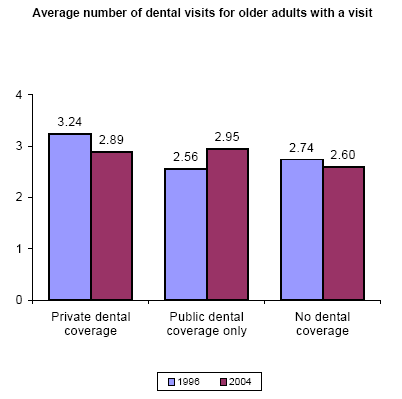
Average number of dental visits for older
adults with a visit |
| |
1996 |
2004 |
| Private dental coverage |
3.24 |
2.89 |
| Public dental coverage only |
2.56 |
2.95 |
| No dental coverage |
2.74 |
2.60 |
|
How has the average dental expense for those with a dental visit changed from 1996 to 2004?
- For high-income older adults, the average expense (adjusted for inflation) increased from 1996 to 2004.

Average dental expense for those with a
dental visit |
|
| |
1996 |
1996 adjusted for inflation |
2004 |
| 65-74 |
$454 |
$547 |
$636 |
| 75 and over |
$409 |
$493 |
$601 |
|
Average dental expense for those with a
dental visit |
|
| |
1996 |
1996 adjusted for inflation |
2004 |
| Poor |
$360 |
$434 |
$822 |
| Low income |
$339 |
$409 |
$491 |
| Middle income |
$508 |
$612 |
$550 |
| High income |
$441 |
$532 |
$691 |
|
- For white non-Hispanics and college graduates, the average expense (adjusted for inflation) increased from 1996 to 2004.

Average dental expense for those with a
dental visit |
|
| |
1996 |
1996 adjusted for inflation |
2004 |
| Black Non-Hispanic |
$534 |
$643 |
$407 |
| Hispanic |
$335 |
$403 |
$656 |
| White Non-Hispanic |
$438 |
$527 |
$630 |
| Other* |
$435 |
$524 |
$557 |
|
Average dental expense for those with a
dental visit |
|
| |
1996 |
1996 adjusted for inflation |
2004 |
| Less than high school |
$452 |
$544 |
$549 |
| High school graduate |
$414 |
$498 |
$552 |
| College graduate |
$459 |
$553 |
$684 |
|
*Other includes non-Hispanics who reported to be of single race other than white or black (i.e., American Indian/Alaska Native, Asian, or Native
Hawaiian/Pacific Islander) as well as non-Hispanics who reported to be of multiple races (possibly including black).
- No significant change (adjusted for inflation) was observed from 1996 to 2004 in average dental expense for older adults with a dental visit, regardless of type of dental coverage.
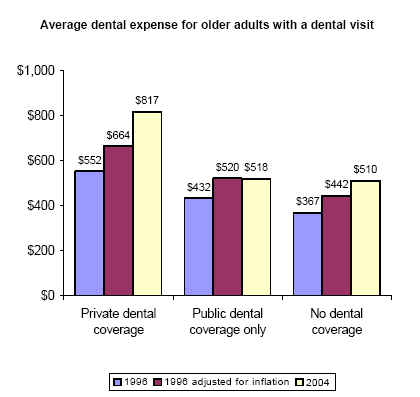
Average dental expense for those with a dental visit |
| |
1996 |
1996 adjusted for inflation |
2004 |
| Private dental coverage |
$552 |
$664 |
$817 |
| Public dental coverage only |
$432 |
$520 |
$518 |
| No dental coverage |
$367 |
$442 |
$510 |
How has the likelihood of having at least one type of procedure changed from 1996 to 2004?
- Older adults were less likely to have at least one restorative or other procedure in 2004 than in 1996.
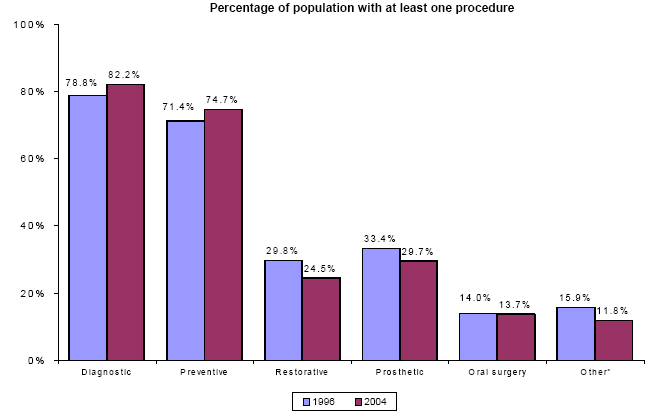
| Percentage of population
with at least one procedure |
| |
1996 |
2004 |
| Diagnostic |
78.8% |
82.2% |
| Preventive |
71.4% |
74.7% |
| Restorative |
29.8% |
24.5% |
| Prosthetic |
33.4% |
29.7% |
| Oral surgery |
14.0% |
13.7% |
| Other* |
15.9% |
11.8% |
*Other includes periodontic (gums), endodontic (root canals), orthodontic (braces), treatment for TMD or TMJ (jaw pain), and bonding, whiting, or
bleaching.
How has the distribution of procedures changed from 1996 to 2004?
- For older adults, the total number of procedures increased from about 64 million in 1996 to about 74 million in 2004
(data not shown).
- As a percentage of all procedures, from 1996 to 2004 diagnostic procedures increased while restorative procedure
types decreased.
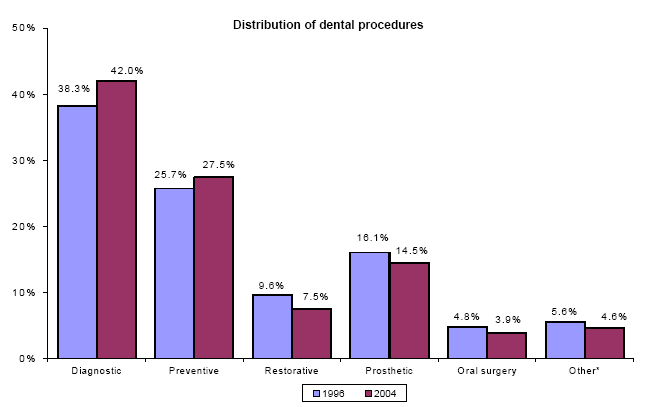
| Distribution of dental
procedures |
| |
1996 |
2004 |
| Diagnostic |
38.3% |
42.0% |
| Preventive |
25.7% |
27.5% |
| Restorative |
9.6% |
7.5% |
| Prosthetic |
16.1% |
14.5% |
| Oral surgery |
4.8% |
3.9% |
| Other* |
5.6% |
4.6% |
*Other includes periodontic (gums), endodontic (root canals), orthodontic (braces), treatment for TMD or TMJ (jaw pain), and bonding, whiting, or
bleaching.
How have dental expenses changed from 1996 to 2004 by category of procedure?
- For older adults, average dental expenses increased from $124 ($149 adjusted for inflation) in 1996 to $184 for
restorative procedures in 2004.
- Expenses for other dental procedures (periodontic, orthodontic, prosthetic, endodontic, and oral surgery) increased from $194 ($233 adjusted for inflation) in 1996 to $403 in 2004.
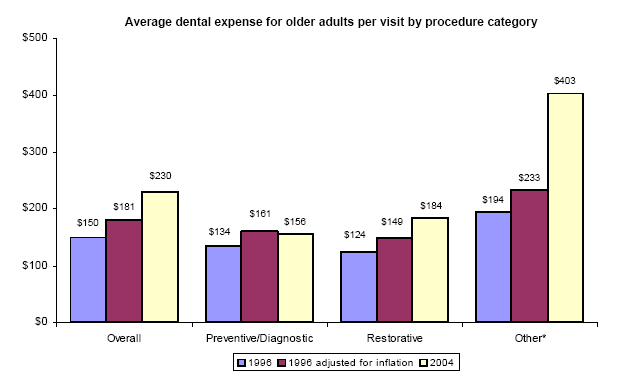
| Average dental expense
for older adults per visit by procedure category |
| |
1996 |
1996 adjusted for inflation |
2004 |
| Overall |
$150 |
$181 |
$230 |
| Preventive/Diagnostic |
$134 |
$161 |
$156 |
| Restorative |
$124 |
$149 |
$184 |
| Other* |
$194 |
$233 |
$403 |
*Other includes periodontic (gums), endodontic (root canals), prosthetic (crown, bridges, and dentures), orthodontic (braces), oral surgery, treatment for
TMD or TMJ (jaw pain), and bonding, whiting, or bleaching.
How has the percentage of older adults with dental coverage changed from 1996 to 2004?
- There were no significant changes in the percentage of older adults with private, public only, or no dental coverage from 1996 to 2004.
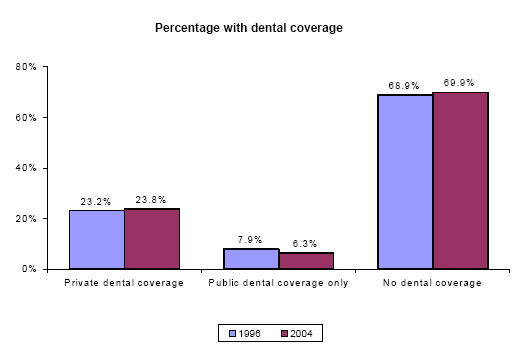
Percentage with dental coverage |
| |
1996 |
2004 |
| Private dental coverage |
23.2% |
23.8% |
| Public dental coverage only |
7.9% |
6.3% |
| No dental coverage |
68.9% |
69.9% |
How has distribution of dental coverage changed from 1996 to 2004?
- No significant changes by age in the percentage of older adults with private dental coverage from 1996 to 2004 were noted.
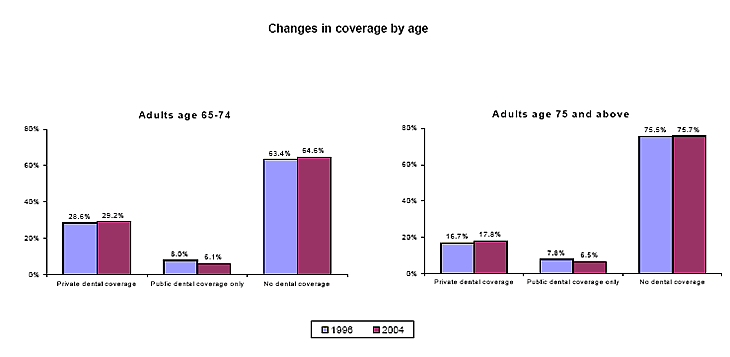
Changes in coverage by age |
|
Adults
age 65-74 |
| |
1996 |
2004 |
| Private dental coverage |
28.6% |
29.2% |
| Public dental coverage only |
8.0% |
6.1% |
| No dental coverage |
63.4% |
64.6% |
|
Changes in coverage by age |
|
Adults
age 75 and above |
| |
1996 |
2004 |
| Private dental coverage |
16.7% |
17.8% |
| Public dental coverage only |
7.8% |
6.5% |
| No dental coverage |
75.5% |
75.7% |
|
- Older adults from a middle-income family were less likely to have private dental coverage and more likely to have no dental coverage than older adults from a family with either lower or higher income in 2004 than in 1996.

Changes in coverage by income |
|
Poor |
| |
1996 |
2004 |
| Private dental coverage |
11.9% |
10.6% |
| Public dental coverage only |
20.0% |
18.0% |
| No dental coverage |
68.1% |
71.3% |
|
Changes in coverage by income |
|
Low
family income |
| |
1996 |
2004 |
| Private dental coverage |
12.3% |
15.2% |
| Public dental coverage only |
10.8% |
10.9% |
| No dental coverage |
77.0% |
73.9% |
|
Changes in coverage by income |
|
Middle
family income |
| |
1996 |
2004 |
| Private dental coverage |
28.5% |
19.3% |
| Public dental coverage only |
4.5% |
3.1% |
| No dental coverage |
67.0% |
77.6% |
|
Changes in coverage by income |
|
High
family income |
| |
1996 |
2004 |
| Private dental coverage |
34.8% |
39.3% |
| Public dental coverage only |
3.3% |
1.8% |
| No dental coverage |
61.9% |
58.8% |
|
- Black non-Hispanic older adults had a significant increase in the likelihood of having private dental coverage from
1996 to 2004.
- White non-Hispanic older adults had a significant decrease in the likelihood of having public dental coverage only
from 1996 to 2004.
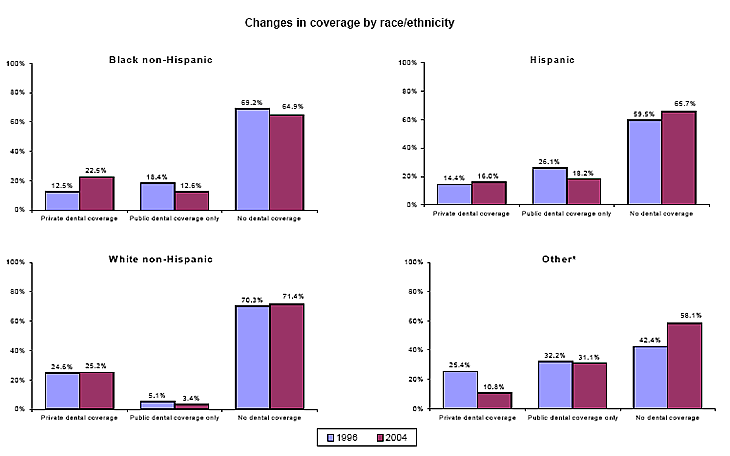
Changes in coverage by race/ethnicity |
|
Black
non-Hispanic |
| |
1996 |
2004 |
| Private dental coverage |
12.5% |
22.5% |
| Public dental coverage only |
18.4% |
12.6% |
| No dental coverage |
69.2% |
64.9% |
|
Changes in coverage by race/ethnicity |
|
Hispanic |
| |
1996 |
2004 |
| Private dental coverage |
14.4% |
16.0% |
| Public dental coverage only |
26.1% |
18.2% |
| No dental coverage |
59.5% |
65.7% |
|
Changes in coverage by race/ethnicity |
|
White
non-Hispanic |
| |
1996 |
2004 |
| Private dental coverage |
24.6% |
25.2% |
| Public dental coverage only |
5.1% |
3.4% |
| No dental coverage |
70.3% |
71.4% |
|
Changes in coverage by race/ethnicity |
|
Other* |
| |
1996 |
2004 |
| Private dental coverage |
25.4% |
10.8% |
| Public dental coverage only |
32.2% |
31.1% |
| No dental coverage |
42.4% |
58.1% |
|
*Other includes non-Hispanics who reported to be of single race other than
white or black (i.e., American Indian/Alaska Native, Asian, or Native Hawaiian/Pacific Islander) as well as non-Hispanics who reported
to be of multiple races (possibly including black).
- There were no statistically significant changes by education in the percentage of older adults with private dental coverage from
1996 to 2004.

Changes in coverage by education |
|
Some or
no school |
| |
1996 |
2004 |
| Private dental coverage |
14.1% |
12.0% |
| Public dental coverage only |
13.4% |
13.6% |
| No dental coverage |
72.4% |
74.4% |
|
Changes in coverage by education |
|
High
school graduate |
| |
1996 |
2004 |
| Private dental coverage |
26.4% |
23.0% |
| Public dental coverage only |
5.0% |
3.8% |
| No dental coverage |
68.6% |
73.2% |
|
Changes in coverage by education |
|
College
graduate |
| |
1996 |
2004 |
| Private dental coverage |
34.0% |
33.6% |
| Public dental coverage only |
3.1% |
3.0% |
| No dental coverage |
62.9% |
63.4% |
|
Return to Table of Contents
References
Cohen J. Design and methods of the Medical Expenditure Panel Survey Household Component. Rockville (MD): Agency for Health Care Policy and
Research; 1997. MEPS Methodology Report No. 1. AHCPR Pub. No. 97-0026.
Cohen S. Sample design of the 1996 Medical Expenditure Panel Survey Household Component. Rockville (MD): Agency for Health Care Policy and
Research; 1997. MEPS Methodology Report No. 2. AHCPR Pub. No. 97-0027.
Cohen, S. Design Strategies and Innovations in the Medical Expenditure Panel Survey. Medical Care, July 2003: 41(7) Supplement: lll-5- lll-12.
Brown E, Manski R. Dental services: use, expenses, and sources of payment, using data from the 1996-2000. Rockville(MD): Agency for Healthcare
Research and Quality; 2003. MEPS Research Findings 20. AHRQ Pub. No. 04-0018.
Monheit AC, Wilson R, Arnett RH. Informing American health care policy: the dynamics of medical expenditure and insurance surveys, 1977-1996.
San Francisco: Jossey-Bass, 1999.
Please consult the MEPS Web site (http://www.meps.ahrq.gov) for an updated publications list and other
information from MEPS. For additional information, contact the MEPS project director at
mepsprojectdirector@ahrq.hhs.gov.
Return to Table of Contents
Definition of Terms
Dental Visit
This refers to care by or visits to any type of dental
care provider, including general dentists, dental
hygienists, dental technicians, dental surgeons,
orthodontists, endodontists, and periodontists.
Dental Coverage Variables
Respondents were asked if they were covered by a
private health insurance plan that included at least
some dental coverage for each round of 1996 and
2004. This information was elicited from a pick-list,code-all-that-apply question that asked what type of
health insurance the person obtained through an
establishment. The list included hospital and
physician benefits, including coverage through an
HMO, Medigap coverage, vision coverage, dental,
and prescription drugs. It is possible that some dental
coverage provided by hospital and physician plans
was not independently enumerated in this question.
Persons with missing information on dental benefits
for all reported private plans and those who reported
that they did not have dental coverage for one or
more plans but had missing information on other
plans are coded as not having private dental coverage.
Respondents who reported dental coverage from at
least one reported private plan were coded as having
private dental coverage.
The variable for dental coverage indicates if a
participant was eligible to receive and/or actually
received payments on their behalf for dental care
obtained during 1996 and 2004. More specifically, an
individual is considered to have dental coverage with
a self or proxy report of dental coverage at any time
during 1996 or 2004. An individual may or may not
have full year coverage. An individual is also
considered to have dental coverage with a self or
proxy report of an insurance payment for dental care
received.
While Medicaid/SCHIP provides medical care
coverage for all enrolled children, Medicaid/SCHIP
dental coverage often varies in scope or reimbursement
level among the different states. The variable
for Medicaid/SCHIP dental coverage indicates if a
participant was enrolled (eligible and enrolled) to
receive dental Medicaid/SCHIP coverage and/or
actually received Medicaid/SCHIP payments on their
behalf for dental care obtained during 1996 and 2004.
Specifically, for 1996 an individual is considered to
have Medicaid dental coverage with a self or proxy
report of Medicaid coverage at any time during 1996
consistent with 1989 OBRA and state regulations and
state eligibility expansions. For instance, pregnant
women in families with a poverty status up to 133%
of the Federal poverty level (FPL), children up to age
6 in families with a poverty status at least up to 133%
FPL, and children up to age 14 in families with a poverty status at least up to 100% FPL are considered
to have Medicaid dental coverage if they have a
report of Medicaid coverage. Additionally, persons
residing in states that expanded Medicaid eligibility
beyond these minimum income requirements are
considered Medicaid covered if they reside in an “expansion state” and report Medicaid coverage.
Expansion states for 1996 include California,
Connecticut, Indiana, Iowa, Maine, Massachusetts,
Michigan, Minnesota, New Jersey, New Mexico,
New York, North Dakota, Pennsylvania, Washington,
and Wisconsin. Persons who qualify as Medicaid
covered at any of the three MEPS interviews are
considered to be covered.
For 2004, an individual is considered to have
Medicaid/SCHIP dental coverage with a self or proxy
report of Medicaid/SCHIP coverage at any time
during 2004 consistent with state regulations and
state eligibility expansions. An individual may or
may not have full-year coverage. In some states,
dental SCHIP coverage was limited or absent during
2004. Persons residing in states that excluded dental
SCHIP are considered to have no public coverage if
not eligible for Medicaid. Delaware and Texas are
SCHIP dental excluded states. Persons who qualify as
Medicaid/SCHIP covered at any of the three MEPS
interviews are considered to be covered. Additionally,
persons residing in states that expanded
Medicaid eligibility beyond these minimum income
requirements are considered Medicaid covered if they
reside in an “expansion state” and report Medicaid
coverage. Expansion states for 2004 include
California, Connecticut, Illinois, Indiana, Iowa,
Kentucky, Louisiana, Maine, Minnesota, Missouri, Montana, Nebraska, New Jersey, New Mexico, New
York, North Carolina, North Dakota, Ohio, Oregon,
Pennsylvania, Rhode Island, South Dakota, Vermont,
Washington, and Wisconsin.
For 2004, an individual is considered to have no
dental coverage if an individual has no report of
private or public dental coverage at any time during
the year.
Education
Education* is expressed in terms of years or formal
education. In this chartbook, the following
classification was used:
- Some or no school—Less than 12 years of formal education
- High school graduate —12 years of formal education
- College graduate—More than 12 years of formal education
*For children 20 years of age and younger, education refers to a caregiver’s (parent or guardian) education.
Expenses
Dental expenditures (expenses). In this report,
expenditures are the amount actually paid for dental
services. More specifically, in MEPS, expenditures
are defined as the sum of payments for care received,
including out-of-pocket payments and payments
made by private insurance, Medicaid, Medicare, and
other sources.
This definition of expenditures differs somewhat
from the definition used in predecessor surveys, the 1987 National
Medical Expenditure Survey (NMES) and the 1977 National Medical
Care Expenditure Survey, in which charges rather than payments
were used to measure medical expenditures. Users who
wish to compare the expenditure data presented in
this report with data from the 1987 and/or 1977
surveys should consult Monheit, Wilson, and Arnett
(1999). AHRQ has developed factors to apply to the
1987 NMCES expenditure data to facilitate
longitudinal analysis. These can be accessed via the
AHRQ Data Center; for information on applying to the AHRQ Data
Center see http://www.meps.ahrq.gov/mepsweb/data_stats/onsite_datacenter.jsp.
Details on the editing and imputation methodology used to develop
the dental expenditure
variables presented in this report can be found in the
documentation for the dental event files. See
http://www.meps.ahrq.gov/mepsweb/data_stats/download_data/pufs/h85b/h85bdoc.shtml for
the 2004 dental event file link.
It should also be noted that it is common for several
dental visits to be included in a single fee. These “flat
fees” are particularly common for orthodontia and
some types of dental reconstruction and surgery. The
flat fee groups may cross calendar years. For flat
fees, expenses for the entire episode are placed on the
initial event. For comparison purposes, an expenditure
amount adjusted for inflation is provided.
Specifically, 1996 expenditures are adjusted to 2004
using a Bureau of Labor Statistics derived factor of
1.20 (our adjustment was calculated as follows: the
CPI is 156.9 for 1996 and 188.9 for 2004; so the
adjustment factor is 188.9/156.9=1.204).
Income
Income is expressed in terms of poverty status, the
ratio of the family’s income to the Federal poverty
thresholds, which control for the size of the family
and the age of the head of the family (see the 2004
U.S. Department of Health and Human Services
Poverty Guidelines at
http://aspe.hhs.gov/poverty/04poverty.shtml for more details). In this chartbook,
the following classification was used:
Poor—Persons in families with income less than or
equal to 100% of the poverty line are considered
poor. Some of these persons are in families reporting
negative income.
Low income—Persons in families with income over
100% through 200% of the poverty line are considered low income.
Middle income—Persons in families with income over 200% through 400% of the poverty line are
considered middle income.
High income—Persons in families with income over 400% of the poverty line are considered high income.
Procedures
Procedures refer to at least one procedure type per
visit. Multiple procedures of the same type at the
same visit are not included. Other service types not
identified by respondents are not included.
Diagnostic = Includes examinations and x-rays
Preventive = Includes cleanings, fluoride, sealants and recall visits
Restorative = Fillings and inlays
Prosthetic = Crowns, bridges, dentures, repairs and implants
Periodontic = Periodontic services only
Endodontic = Endodontic services only
Orthodontic = Orthodontic services only
Other = Any other dental service not included above
Population Characteristics
In general, population characteristics were measured
as of December 31st of the year of study (1996 or
2004), or the last date that the sample person was part
of the civilian noninstitutionalized (community)
population living in the United States prior to
December 31st of that year.
Comparisons by race/ethnicity in this chartbook are
based on the following four race/ethnicity groups:
black non-Hispanic, white non-Hispanic, Hispanic,
and other. Other includes non-Hispanics who reported
being of a single race other than white or black (i.e.,
American Indian/Alaska Native, Asian, or Native
Hawaiian/ Pacific Islander) as well as non-Hispanics
who reported to be of multiple races (possibly
including black).
Caution should be used when drawing conclusions
based on comparisons of race/ethnicity groups for
2004 versus 1996 because the true racial composition
of each of the identified race/ethnicity groups cannot
be guaranteed to be the same across these years.
Return to Table of Contents
Suggested Citation:
Manski, R. J. and Brown, E. Dental Use, Expenses, Private Dental Coverage, and Changes, 1996 and 2004. Agency for Healthcare Research and Quality, Rockville, MD.
http://www.meps.ahrq.gov/data_files/publications/cb17/cb17.shtml |
|
